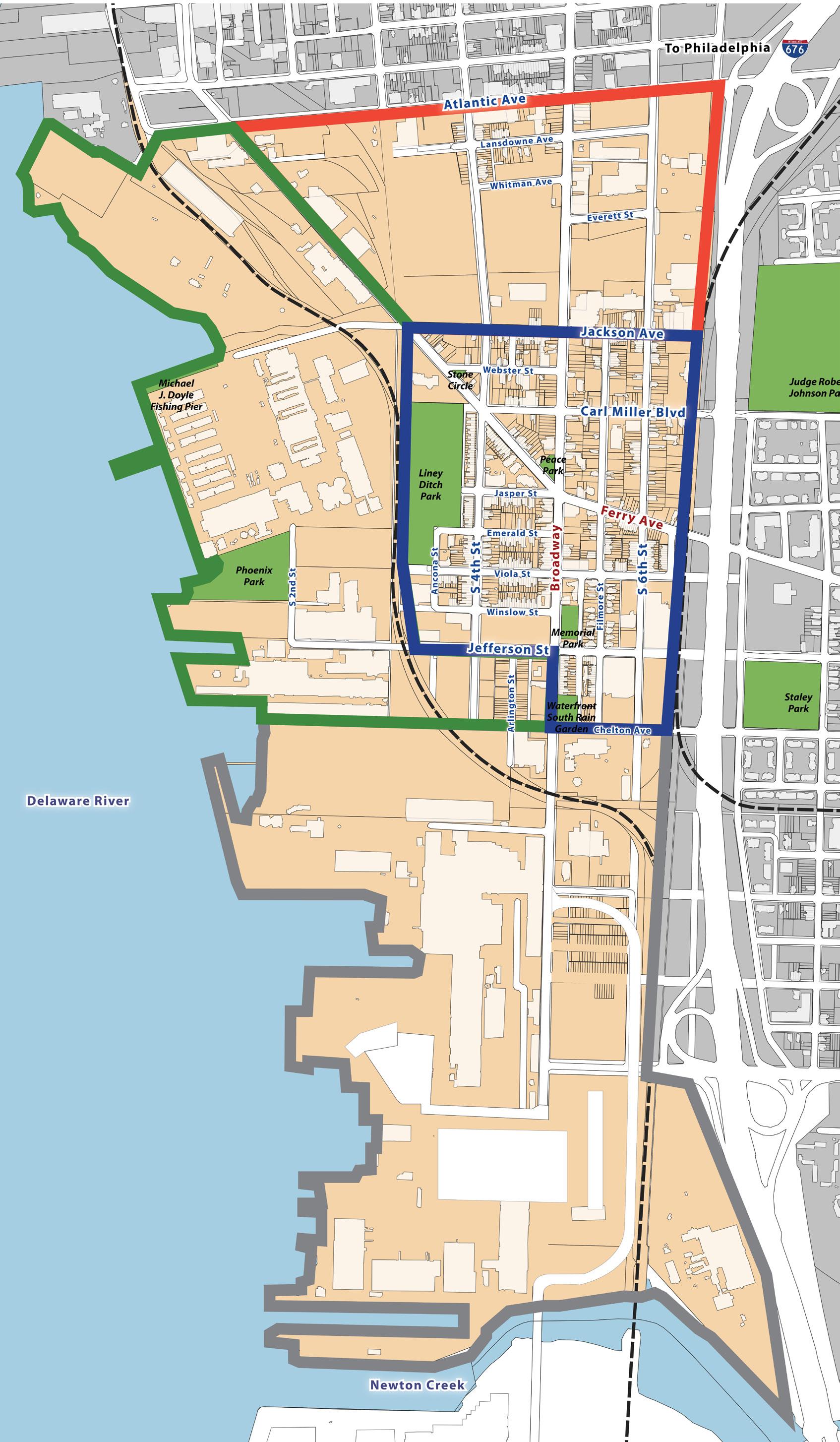
89 minute read
CHAPTER 2: NEIGHBORHOOD PRIORITIES & RECOMMENDATIONS
CHAPTER 2
Neighborhood Priorities & Recommendations
Plan recommendations are organized around three overarching goals and ten priorities. Overarching goals describe ultimate outcomes anticipated once neighborhood projects are completed.
Strengthen
Build from the core, strengthening residential blocks and creating economic opportunities for neighborhood businesses and local entrepreneurs. Leverage neighborhood assets to reverse population loss, retaining existing residents and attracting new ones. Promote a clean, healthy, safe and thriving community for all.
Connect
Improve connections with the Waterfront as an integral part of the community.
Improve connections to businesses located in the Economic Zone with a safer and improved public realm. Improve connections with downtown Camden and adjacent neighborhoods.
Grow
Establish a framework for growth with improved neighborhood capacity, where residents are engaged and organized, community organizations have the resources required to advance community projects and solid partnerships are established between residents, organizations, institutions, government and businesses
Connect to the City •Atlantic Ave as a city gateway •Improved connections •New services and amenities •Mix of land uses
•Anchor development
Strengthen •Healthy and clean environment •Green infrastructure •Improved connections •Housing choices •Safe and clean streets •Economic growth and opportunity •Community amenities and services
Connect to the Waterfront •Waterfront as a public amenity •Improved public realm
•Improved connections
Connect to the Economic Zone •Improved public realm •Address eyesore industrial areas •Signage and wayfinding
•Green infrastructure
1
A Healthy & Clean Environment
“Our neighborhood is a sacrifice zone. By hosting a disproportionate share of county waste services and other polluting facilities, Waterfront South bears the collective burden of our region. The environmental injustices of our neighborhood are bad and getting worse, and we need a comprehensive plan and structural support to change the status quo. We need tools like this neighborhood plan to give us leverage to fight for a better future for our kids.”
region. The environmental injustices of our neighborhood are bad and getting worse, and we need a comprehensive plan and structural support to change the status quo. We need tools like this neighborhood plan to give us leverage to fight for a better future for our kids.” Mike Morgan, Waterfront South Resident “Our neighborhood is a sacrifice zone. By hosting a disproportionate share of county waste services and other polluting facilities,
For decades, Waterfront South residents have been faced with the risks associated with a disproportionately high concentration of environmental hazards located within the neighborhood’s square mile. Between regional utilities, industrial plants, close proximity to the port and regional transportation corridors, the neighborhood is routinely impacted by a number of environmental stressors that negatively impact quality-of-life and health outcomes for residents and their families. Significant concerns about air pollution associated with industrial activities and truck traffic, noise, odors, land and water contamination were reported by the community during the planning process.
Although positive efforts have been made in the past twenty years by individual agencies and industries to mitigate the environmental risks associated with their operations, exposure to high levels of air pollutants is still a top concern, further amplified in recent years by repeated incidents connected to local business operations. Just in the past year, two major fires occurred at EMR’s scrap metal recycling facility, sending noxious smoke and odor over the neighborhood, exacerbating already high levels of existing respiratory conditions, and leaving residents stranded and unable to return to their homes for hours. Concerns about expansion of the industrial footprint in the neighborhood and lack of clarity about permitting, land use approvals and monitoring are top priorities among community members. Moreover, residents cite the lack of public engagement from industry and governmental agencies, and scarce community control over land use approvals as contributing to the environmental burden of this majority minority community.

As an area historically marked by the presence of industrial uses, the Waterfront South is also challenged by a concentration of contaminated sites. A 2016 NJDEP map identified 23 known contaminated sites in the neighborhood. Targeting site clean-up for future redevelopment is another fundamental priority for the next ten years.
Finally, preparing the neighborhood for resilience against the impact of climate change remains central to this riverfront community. As a low-lying section of the City, the neighborhood is also threatened by flooding risks and combined sewer overflow (CSO). The 2020 Green Infrastructure Plan for the Waterfront South identified a number of opportunities for green infrastructure projects to minimize risks in the neighborhood. Recommendations from that plan inform the strategies presented below.
1.1 Establish regular communication with NJ DEP and the Office of Environmental Justice
Work in partnership with NJ DEP and the Office of Envrionmental Justice to remove barriers to accessing resources to better inform and advocate for environmental justice in Waterfront South. The Office Environmental Justice was created by NJ DEP to ensure fair and equitable treatment in decisionmaking that affects residents and their environment, communities, homes and health. It directs NJ DEP to develop guidance for all NJ state departments to incorporate environmental justice considerations into their actions. And, it calls for the NJ Department of Health and the NJDEP to continue to expand the NJ Environmental Public Health Tracking Network. The Network collects data on health, human exposures, and environmental hazards.
While NJ DEP makes data about air emissions generated by individual uses available to the public, there is little information about the cumulative impact of those uses to the community. The NJ Environmental Justice Law passed in 2020, stipulates that DEP assess the public health and environmental risks created by facilities as they renew or expand licensing permits in overburdened communities. Waterfront South residents will benefit from a clear understanding about the permitting process and mechanisms to stay up to date regarding permit applications. A first step in that direction could include outreach to NJ DEP for educational seminars, walking residents through the new regulatory requirements and opportunities for community input. Furthermore, the NJ DEP should provide periodic reports and updates to local neighborhood groups and their representatives regarding information about new requests for expansion of existing businesses, potential siting of new industry, brownfield identification and remediation updates, and provide information on how the DEP, itself, is actively reducing the negative environmental impacts on the overburdened community of Waterfront South. 1.2 Monitor neighborhood air and water quality a. Leverage community-based air monitoring as tools for education and informed action An important step in addressing risks associated with air pollution is to raise awareness and help educate residents and local businesses about air quality in the community. Community-based monitoring efforts such as the Purple Air monitor installed at CFET on Ferry Avenue provide up to date information about air quality that is both relevant and actionable for individuals and communities. The Purple Air monitor is a sensor that collects local air quality data and enables CFET to share that data with the Waterfront South community. Identifying mechanisms to expand awareness about the neighborhood monitor and educating residents about the information available will help increase awareness and lead to proactive engagement in the dialogue with industrial neighbors and governmental agencies. Potential ways to disseminate information in the community include:
❱ Include regular updates about air quality in the agenda for monthly resident meetings.
❱ Invite residents to educational sessions about air quality monitoring along with information about monitors installed in the City and neighborhood.
❱ Spread the word about resources available online and through apps such as Purple Air (https://map. purpleair.com) and EPA’s AirNow (https://www.airnow. gov
❱ Secure funding for citizen science projects to collect data on local pollution and evaluate potential risks to public health.
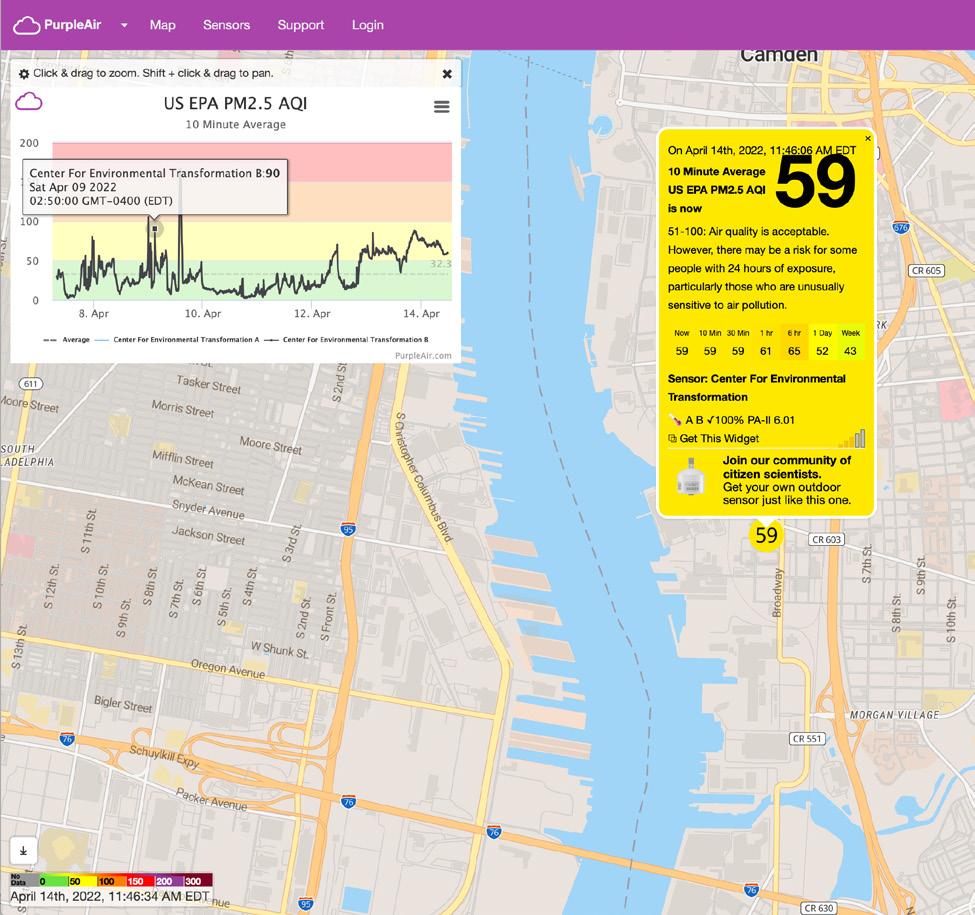
Air Monitor
The purple air monitor in Waterfront South is a resident led initiative. The monitor is located at CFET and provides up to date air quality information on particulate matter. The above screenshot exemplifies the information available online. Waterfront South Neighborhood Plan 54
b. Advocate for, receive, and assess comprehensive air monitoring and data While community-based air monitoring provides a helpful low-cost reference about local air quality, the need for comprehensive monitoring beyond the typical particulate matter data provided by systems like Purple Air remains as a priority for community members. The Spruce Street Station located in downtown Camden tracks a broader range of pollutants but may not capture the more specific conditions presented in the southern section of the city. Re-installing the air monitor originally located at CCMUA should provide a closer portrait of the environmental conditions in the neighborhood. NJ DEP is the agency responsible for the CCMUA sensor.
c. Identify household level solutions to mitigate the impact of air pollution in indoor air quality. This two-fold recommendation includes both an educational and financial component.
❱ Education: While permanent solutions addressing air quality are the ultimate goal for the Waterfront South and region, short-term initiatives at the household level will help mitigate the impact of air pollution and minimize potential health effects for individuals at risk living in the neighborhood. Educational seminars about household level solutions to improve indoor air quality is a potential community initiative to help ensure livable conditions within people’s homes.
❱ Financial: Individual indoor solutions are often costly for residents living on fixed incomes. Grants and partnerships with manufacturers can help bridge that gap. A potential approach can include a stipend for air quality solutions as a component of home repair and upgrade programs recommended under Priority 3 –
Housing Choices.

d. Advocate for and undergo an updated air quality report with NJDEP The Waterfront South Air Toxics Pilot Project prepared by NJDEP in 2005 provided the community with a critical reference about air toxics and particulate matter impacting air quality in the neighborhood. The study assessed air pollution sources, identified air toxics and particulates with greatest health risks, assessed levels of pollution found in the area and identified strategies to mitigate health risks. Although the 2005 study remains relevant as historic baseline data, having informed several mitigation efforts over the past decade, much has changed since 2005 with respect to industrial activities, with new industries moving in and other businesses closing or relocating. Likewise, environmental parameters have changed over the years, justifying the need for a new comprehensive air quality assessment.
1.3 Ensure community decision making in land use decisions that may increase environmental and health risks
“…Overburdened communities must have a meaningful opportunity to participate in any decision to allow in such communities certain types of facilities which, by nature of their activity, have the potential to increase environmental and public stressors and, that it is in the public interest for the State, to limit the future placement and expansion of such facilities in overburdened communities”
(NJ State Environmental justice Law, Chapter 92, C.13:1 D-157)
The 2020 NJ Environmental Law provides a framework for community participation in decision making related to industrial facilities planning to establish or expand their footprint in the neighborhood. While standard City permitting and processes around development projects welcome public input and participation, a special review process should be considered for environmental justice communities with an eye on the specific environmental impact of new projects in the area. Beyond land use impact, communities should be informed about the environmental implication of proposed projects.
1.4 Target brownfield sites within the residential core for redevelopment
There are several brownfield sites in close proximity to the residential core of the Waterfront South. This plan provides general recommendations for the future use of these sites, establishing priorities for investment according to community priorities.
a. Prioritize the Howland Croft mill property for site clean-up and redevelopment Situated on the south end of Broadway, the Howland Croft Mill housed a garment factory for over 70 years. In 1928, the mill employed over 300 people from Camden, drawing its workers heavily from the surrounding neighborhood. The business remained open until the 1950s and served primarily as a storage facility since then until an eight-alarm fire destroyed the property in 2011, displacing residents from surrounding properties, and leaving behind an old gas stack as the only vestige of the factory’s footprint. The property occupies an entire city block comprising 1.7 acres of land and can serve as a community anchor along Broadway with economic development opportunities generating jobs, services and housing options in the neighborhood. The property is currently zoned for residential uses (R-2) and could accommodate the community’s vision for a mixedincome multi-family housing development with ground floor retail or community services and an affordable senior development. Site remediation is naturally a key first step in that process and one that will inform the feasibility of residential uses in the property. Efforts should be made on the short-term to place the property in the City’s priority list for funding towards remediation.
b. Assess the conditions of other brownfield sites for future redevelopment The planning team identified 16 other brownfield properties in the neighborhood for consideration in future redevelopment plans. Six of these properties are located within the residential core (between Jackson Street and Chelton Avenue) and should be evaluated in the context the neighborhood’s overall vision for housing and economic development. A preliminary assessment of each property based on past uses will help identify directions for future reuse.
The Howland Croft Mill building was destroyed by a fire in 2011. The site should be prioritized for environmental assessment, remediation, and redevelopment.
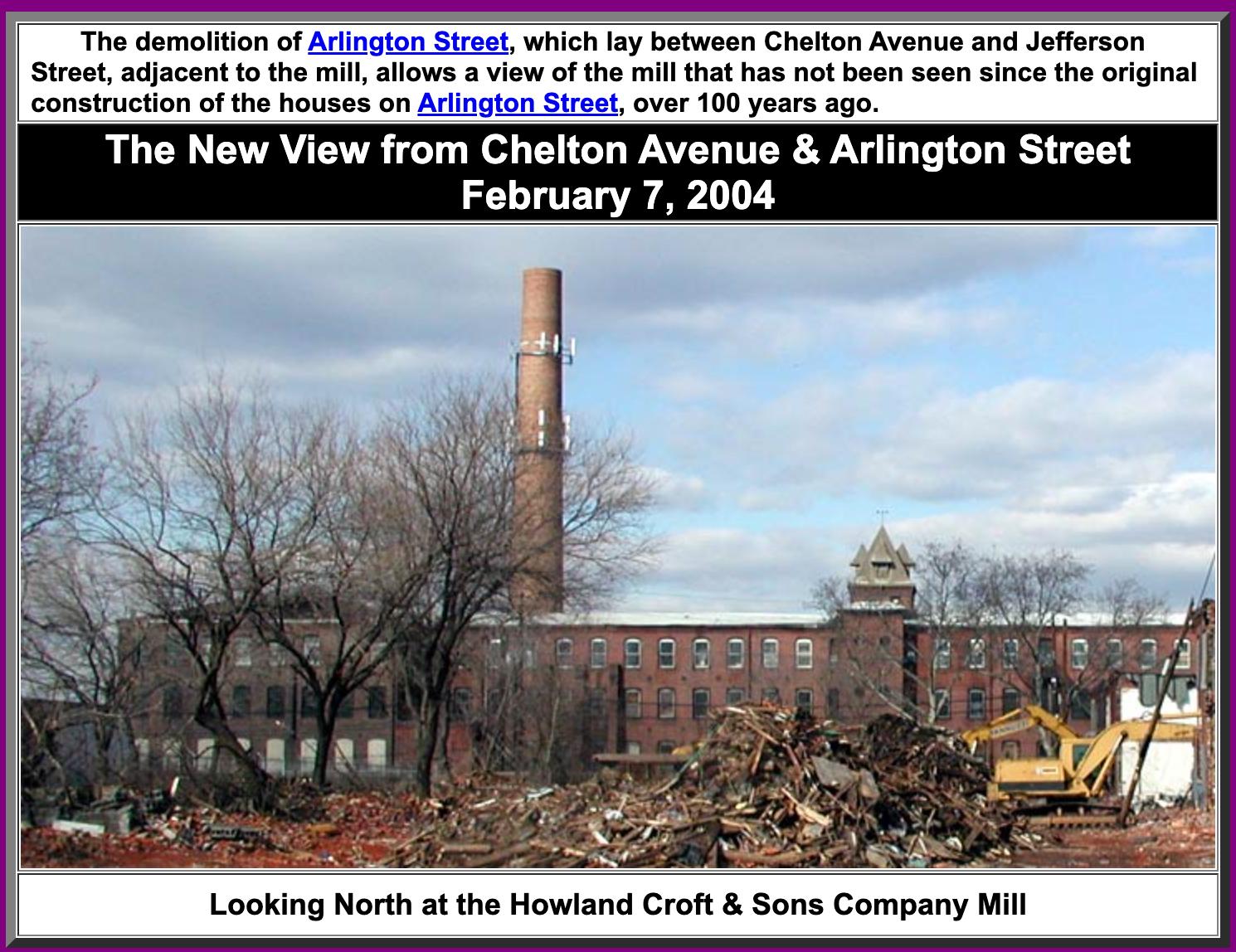
Source: NJDEP, 2016 Data One of the brownfield properties situated along the eastern end of the neighborhood is included in plans for the future Light Rail Stop proposed between Ferry Ave and Carl Miller Blvd.
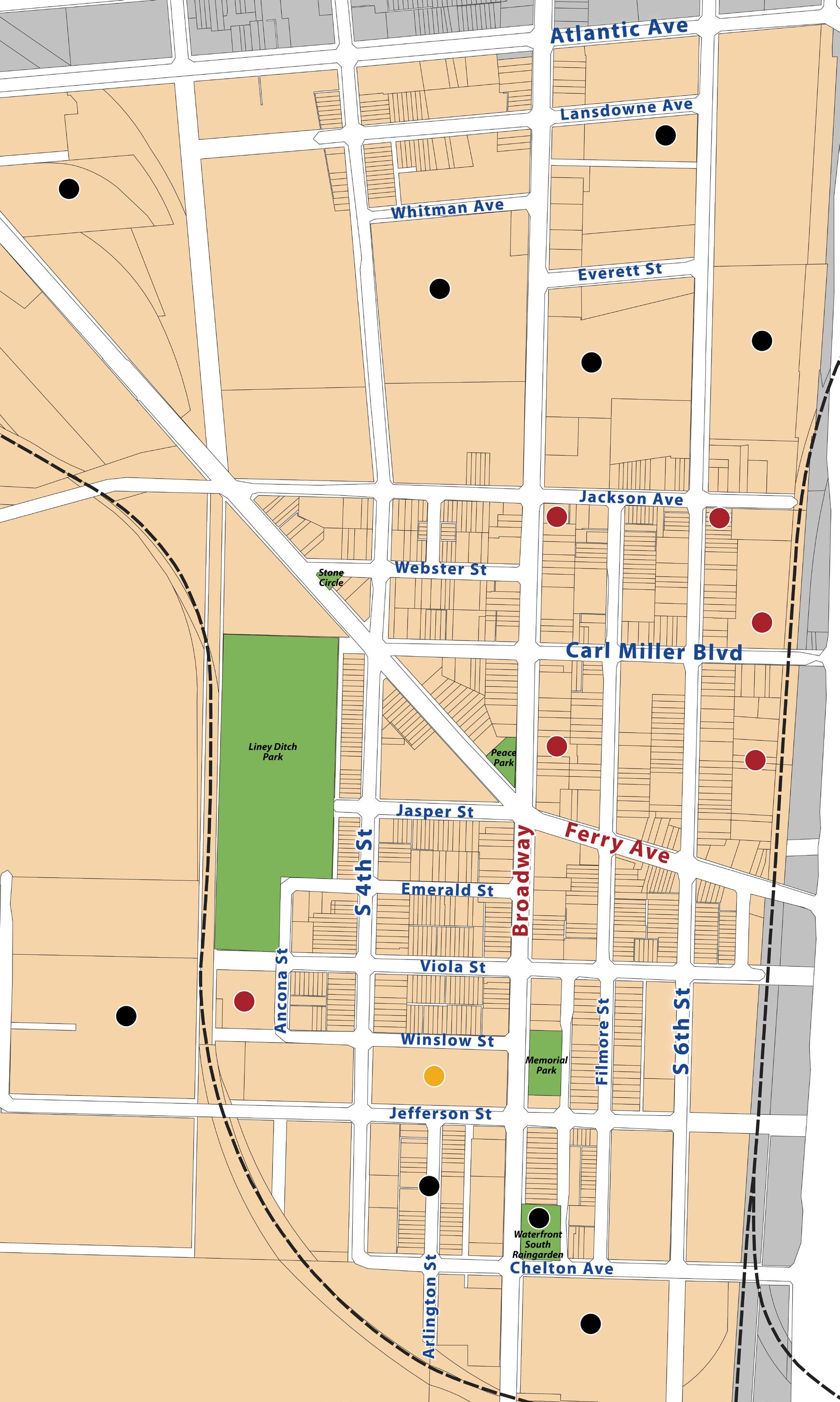
Legend:
Property for remediation and redevelopement
Croft Mills site
1.5 Green Infrastructure
The City of Camden, through the Camden SMART Initiative, has been aggressively focusing on the implementation of green infrastructure projects to mitigate the risks of flooding and combined sewer overflow. Waterfront South has been a key target area for such projects due to its character as a lowlying waterfront community prone to flooding and combined sewer overflow events. CCMUA, a key partner of the Camden SMART Initiative, has been at the forefront of neighborhood initiatives, as both a neighborhood partner and as an agency seeking to minimize the impact of CSO events on the City’s infrastructure. As the agency sponsoring both the 2020 Green Infrastructure Plan and this 2022 Neighborhood Plan, CCMUA is the natural implementation partner for future green infrastructure projects. Recommendations described below prioritize opportunities within City owned properties, public rights-of-way, parks and open spaces. Partnerships with industrial facilities should help identify additional opportunities within port land and other privately owned industrial properties. Further details about those opportunities are described under Priority 7 of this Neighborhood Plan.
a. Expand tree coverage at parks and neighborhood streets The Camden Parks and Open Space Plan identifies the Waterfront South as a high to very high priority area for mitigating urban heat islands. Expanding tree coverage along neighborhood streets is an effective strategy to reach that goal. Beyond their role in helping offset rising temperatures, trees also trap pollutants and mitigate runoff and flooding. Partnerships between residents, CCMUA, the NJ Tree Foundation, local organizations and businesses can help leverage technical capacity, funding, coordination and community participation towards a multi-year effort targeting residential blocks on a first phase and expanding the reach along neighborhood corridors and industrial areas. Phoenix Park was identified by residents as a priority area for tree planting to further encourage the use of the park in the summer. Trees will also have a positive impact on future plans for Broadway Avenue, providing shading and cooling and encourage pedestrian traffic. The Greening Waterfront South Plan focuses on mitigating flooding and combined sewer overflows in the neighborhood. Multiple types of GSI projects have been identified as stormwater management solutions for the community:

a. BIoswale b. Constructed Wetlands c. Green Roofs d. Naturalized areas e. Parking lot retrofits f. Rain gardens g. Rooftop capture and reuse h. Stormwater bumpouts
i. Tree trenches
Source: Camden Parks & Open Space Plan, 2020 Waterfront South is identified as a priority area for projects mitigating urban heat islands
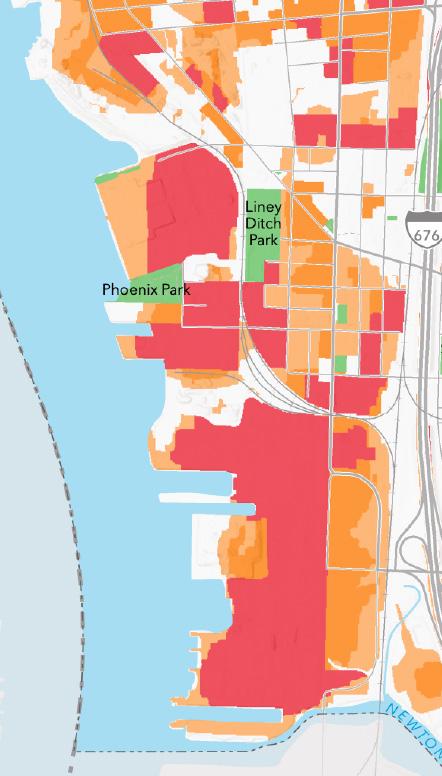
b. Parks and open spaces The 2020 Greening Plan describes improvement opportunities at two of the neighborhood’s main parks: Liney Ditch and Phoenix Park. Conceptual plans highlight options for bioswales, rain gardens and storm inlets at Liney Ditch. Tree planting and deeprooted planting zones are identified at Phoenix Park. In an effort to align these recommendations with the input received from the community in this planning process, the following steps are recommended:
❱ Target Liney Ditch as a priority park for investment. Liney Ditch is highly valued as an active community amenity and has been identified as a priority for investments. A first step in that direction includes the development of a comprehensive improvement plan integrating programming, safety, green infrastructure, and maintenance. Organizations like Project for Public Spaces and The Trust for Public Land can support this effort through design grants and community driven solutions to re-activate the park while maximizing green infrastructure opportunities.
❱ Support CCMUA’s ongoing efforts to improve residents’ experience at Phoenix Park through a combination of tree planting, green infrastructure, programming, and public safety initiatives.
❱ Among existing neighborhood parks, Memorial Park provides another great opportunity for coordinated programming, beautification, and green infrastructure initiatives aimed to reclaim that open space as a focal point for the community. Situated along the southern end of Broadway Avenue, the park is rarely enjoyed by local residents, having become a place for prostitution and drug activity. Green infrastructure initiatives including a rain garden should be an integral part of the future planning of the park.
Source: Greening Waterfront South Plan, 2020


Proposals for Liney Ditch and Phoenix Parks from the Greening Waterfront South Plan
c. Leverage maintenance of green infrastructure as an economic opportunity for residents A recurring concern expressed by residents with respect to green infrastructure projects relates to maintenance and upkeep of those spaces. PowerCorps Camden, a current partner for the City’s green infrastructure initiatives, provides job training and opportunities to young residents in the City. A targeted effort to identify young residents of the Waterfront South as ambassadors for local green infrastructure projects with a key role in maintaining and educating neighbors about existing and future neighborhood installations, would ensure consistency in maintenance efforts while also promoting skill building and leadership opportunities among young residents.
d. Adopt property-based solutions Solutions at the residential level will be a key component in the effort to improve resilience and mitigate the growing impact of weather events in the community. Several organizations in the region already have programs dedicated to education and technical assistance to residences and small commercial property owners looking to implement stormwater solutions in their properties. CCMUA and the Rutgers Cooperative Extension Water Resources Program are key community partners in the City. A targeted campaign to Waterfront South residents could include classes and training sessions along with supplies such as rain barrels and other materials at no cost or discounted prices.
Power Corps Camden
Power Corps Camden provides training and a living stipend to Camden youth working on projects that improve stormwater management, clean and green vacant lots and improving community space and parks. On completion of the six-month term of service Power Corps, alumni receive assistance with continuing education, extended national service opportunities and job placement in career-related fields. 1.6 Promote Environmental Awareness and Stewardship
Beyond public and private investments aimed at improving environmental conditions in the neighborhood, programs engaging local families in environmental initiatives will help raise awareness among residents about the positive impact of individual choices and actions and the role each person can play as a caretaker of the environment. The following activities exemplify positive initiatives to be developed in partnership with local groups. CFET is a natural partner in this effort:
❱ Promote zero waste events and discourage single use disposable giveaways in local community events.
❱ Develop a local campaign educating residents about trash, re-use and recycling.
❱ Create a community tool shed.
❱ Promote neighborhood walks along the waterfront with opportunities to learn about the wildlife diversity that inhabits the area.
1.7 Adopt and Enforce Green Standards
As the community moves forward with plans for future housing and economic development, efforts should be made to minimize the impact of new buildings on local infrastructure while also contributing to improve neighborhood environment through ecologically sound design and construction solutions. Between State, County and City ordinances, there is a solid regulatory framework guiding future development towards best practices. Residents and community stakeholders can have a critical role tracking proposed development projects and ensuring the critical attention required to minimize any potential negative impact on the neighborhood.
Camden Sustainability Ordinance
The City of Camden became the first municipalitiy in New Jersey to adopt a sustainablity ordinance in 2015. The ordinance requires an Environment Impact and Benefit Assesment before projects are approved.
2
Improved Neighborhood Connections
Waterfront South’s residential fabric is, in many ways an island. Encroached by industrial uses and severed from neighboring Centerville by the elevated interstate highway on the east, the community is poorly connected to the City and region. Pedestrian, bicycle and vehicular connections to vital City resources and nearby communities are challenged by insufficient infrastructure. While, truck traffic accessing the industrial zone regularly traverses residential streets, compromising public safety, bringing noise and air pollution. Waterfront South and the City of Camden will benefit from the opportunities presented from improved connections. An open and linked community will result in stronger economic growth, encourage development, and improve amenties and services.

A multifaceted approach is needed to strengthen connections between Waterfront South and adjacent communities and improve safety and circulation within the community. Additional measures are required to steer truck traffic away from residential streets and increase safety on Broadway and Ferry Avenue. Residential streets and sidewalks within the community are in need of repair and safe bike routes connecting residents to downtown Camden and to waterfront amenities is a high priority for community members. Implementing a program of green and complete streets on major corridors will forward connectivity and increase resilience. In addition to enhanced community corridors, reimagined underpasses as gateways, well-lit and beautified with local art, will express neighborhood pride and welcome visitors. For residents without access to a car, public transit is a critical link to jobs and services. Improving currently inhospitable bus stops and expanding mobility will strengthen connections to the city and the region. The following recommendations require coordination with City and County agencies as well as NJ Transit
2.1 Eliminate and reroute truck traffic away from the residential area
a. Short-term steps Despite recent County and City efforts to restrict truck traffic to a limited area of the neighborhood, truck presence in the residential area, and especially on Ferry Avenue and Broadway, are still a top concern among residents. Beyond noise, air pollution and constant vibrations generated by large size trucks, residents reported a number of circulation issues experienced by local drivers and pedestrians including speed, visibility at crosswalks and intersections, and incidents with cars parked on the streets. b. Long-term step While the ultimate goal is to have truck traffic eliminated from the core residential area, steps should be taken on the short-term to manage trucks by regulating traffic hours, enhancing signage and limiting the types and sizes of vehicles allowed in the neighborhood. Traffic enforcement, including penalties and fines is a critical component of this strategy, Central Gateway
Waterfront Cooper
requiring regular police enforcement and monitoring Lanning Parkside from the neighboring businesses that generate truck trips in the area.

Central Waterfront Cooper LanningBroadway
GatewayLiberty
Park
Whitman Park Parkside

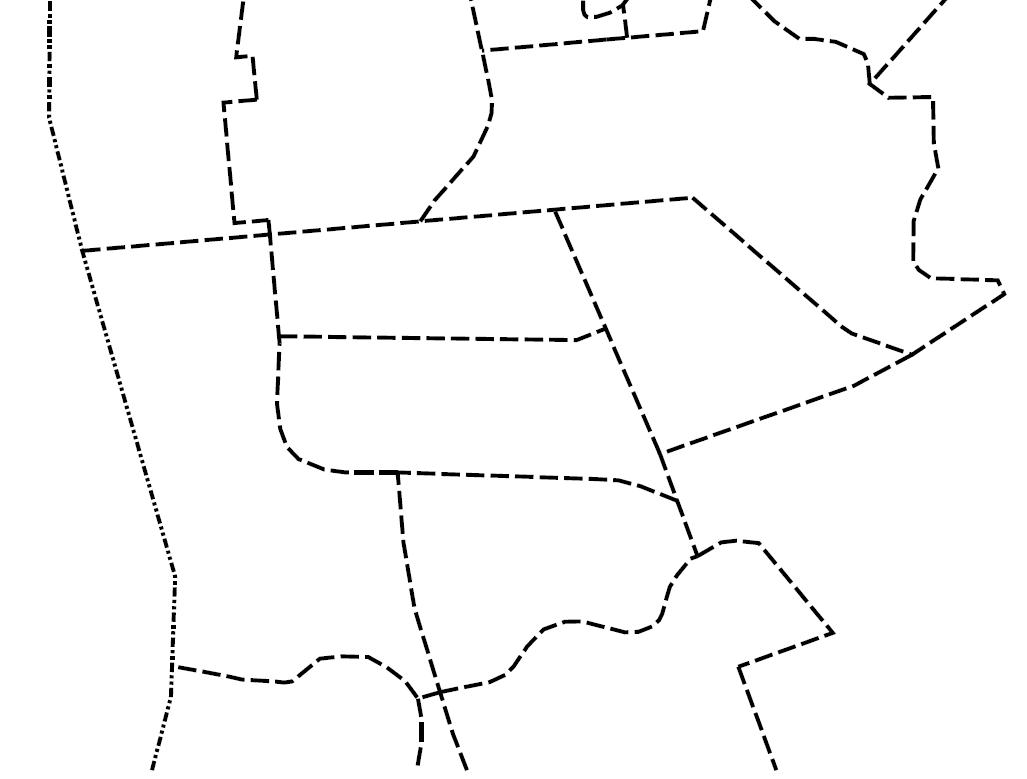
Centerville
Waterfront South BroadwayBroadway
Liberty Woodland Ave Park
Morgan Blvd
Morgan Village
Centerville
Fairview Whitman Park
Waterfront South Woodland Ave
Broadway Morgan Blvd
Morgan
VillageCamden City Port Access Truck Route Location Map
Second Street (Camden City) Reconstruction Atlantic Avenue (Camden City) Reconstruction Ferry Avenue (CR 603) Reconstruction Broadway (CR 551) Reconstruction
Camden County truck route plan 2.2 Repair streets in bad conditions Fairview
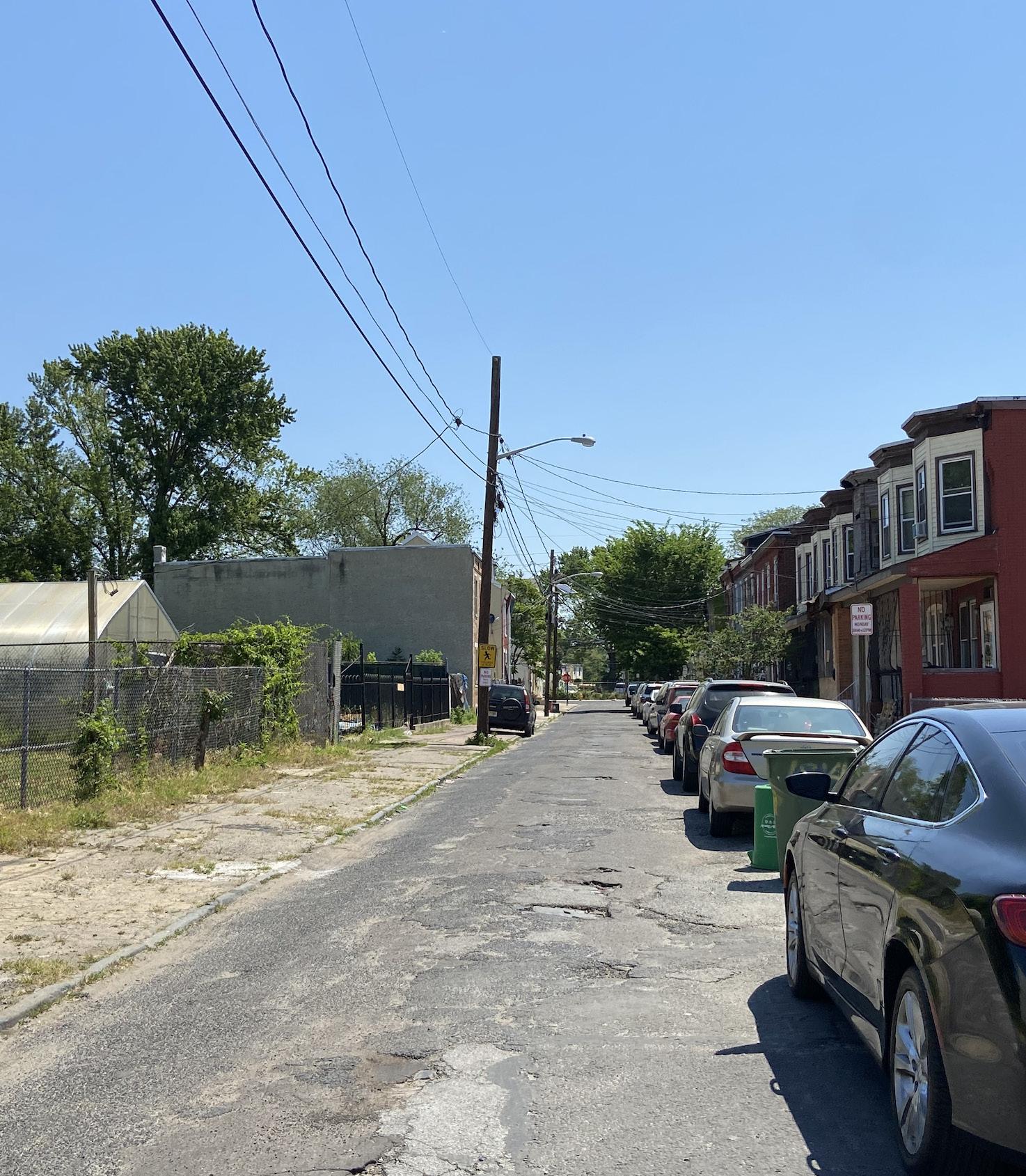
Like many of the City’s neighborhoods, several streets Camden City Port Access Truck Route Location Map
Second Street (Camden City) Reconstruction
in Waterfront South are poorly maintained and Atlantic Avenue (Camden City) Reconstruction inadequate for safe driving and circulation. Potholes, grade defects, cracks and other hazardous conditions damage cars and promote accidents. A citywide assessment of street conditions performed in the past two years will help guide priorities for road repairs. The existing street conditions map describes the results of the street assessment, highlighting Filmore Street, Winslow street and 6th Street as top priorities for road repairs.
Ferry Avenue (CR 603) Reconstruction Broadway (CR 551) Reconstruction
Source: City Assesment, 2021
Existing Street Conditions
Failed Very Poor Fair
Serious Poor Satisfactory Good
Emerald St shows poor street conditions from City’s assessment
2.3 Pedestrian safety
Waterfront South’s dense residential core is a compact and walkable community with a street network established prior to automobile dominance of the cityscape. While the community’s DNA is naturally pedestrian friendly, degraded sidewalks compromise walkability and deter pedestrian movement. Assisting homeowners and property owners with critical sidewalk repairs and addressing the gaps in sidewalk maintenance created by vacancy is a priority to help maintain walkability. Targeted crosswalk and signage improvements at critical locations such as the area around the Sacred Heart School will enhance safety in the community. The intersection of Broadway and Ferry Ave, a critical crossroads at the heart of the community, deserves specific attention with potential reconfiguration geared at prioritizing pedestrian safety and deterring commercial traffic from cutting through residential blocks. 2.4 Establish a safe bike route to the waterfront and downtown Camden
Efforts to improve bike connections throughout the City should include a safe and dedicated bike route connecting Waterfront South residents to downtown Camden. The following diagram describes a proposed route down Ferry Avenue to 2nd Street. Broken down in three segments, the proposed bike lane would run as a shared lane on Ferry Avenue, and as a dedicated lane within the 70ft right-of-way of 2nd Street. This concept is consistent with three other plans calling for a bike route on Ferry / 2nd Street corridors. County’s efforts to implement sections of the Port truck traffic circulation plan provide a concrete opportunity to fund and build this bicycle connection in the next few years.
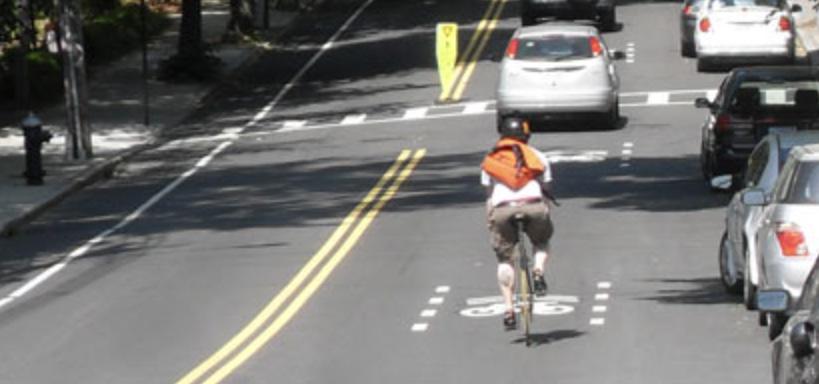
Segment 1: Bike Sharrows
4
3
2
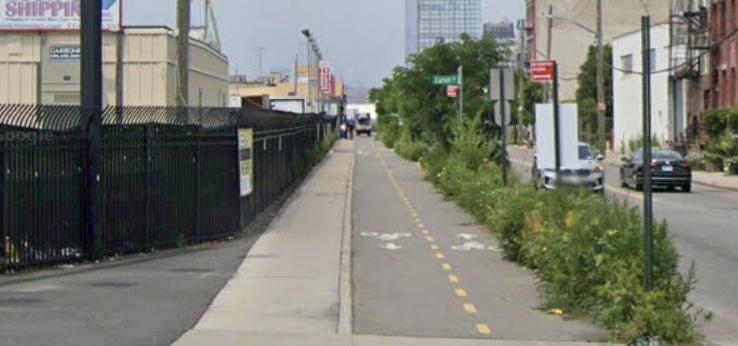
Segment 2&4: 2-way sidewalk bike lane
To Philadelphia
Atlantic Ave
Lansdowne Ave
Whitman Ave
Everett St
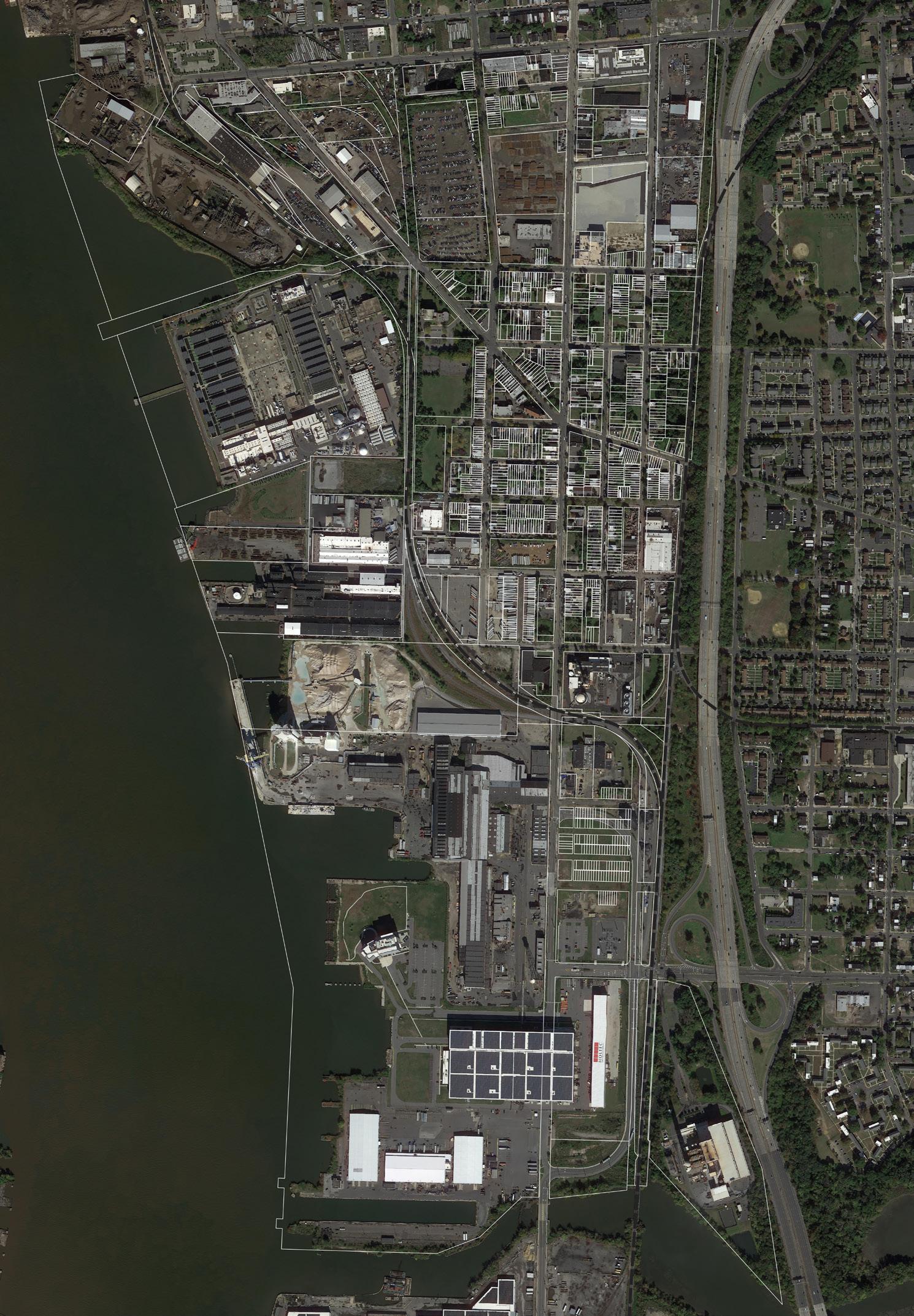
S 2nd St Ancona St Webster St
1
Jasper St
S 4th St
Emerald St
Viola St
Winslow St Broadway
Jefferson St
Arlington St Jackson Ave
Carl Miller Blvd
Ferry Ave
Filmore St S 6th St
Chelton Ave
Segment 3: 2-way parking protected bike lane
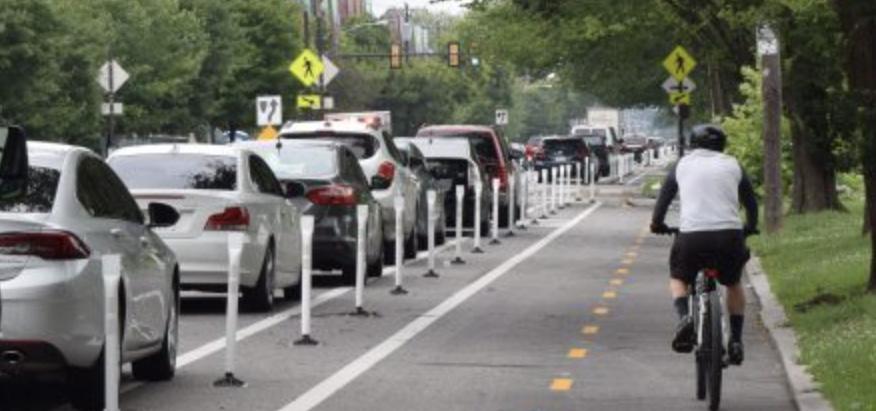
4
3
Current Proposed
2
1
2.5 Implement green and complete streets along Broadway and Ferry
Waterfront South is one of the neighborhoods identified by EPA on a 2016 Green and Complete Streets report for the City of Camden as an opportunity area for green and complete streets. The report lists Ferry Avenue as a top contender due to flooding risks and recommends further investigation for other potential streets. Converting the two main neighborhood corridors into green and complete streets will positively impact the community, enabling residents to move safely along these high traffic areas while integrating much needed green stormwater infrastructure as concrete measures to decrease flooding risks and minimize impact on the City’s combined sewer systems.
2.6 Reconfigure 4th street as a one-way street 4th Street is an important residential corridor in Waterfront South with intense vehicular traffic generated by residences, school, park and the theater. Concerns about traffic and pedestrian safety have led community members to identify the conversion of the street from a two-way to a one-way corridor as a desired solution to discourage drivers who speed through the street from Ferry Avenue. A traffic study is recommended to identify the most appropriate solution for the area, taking in consideration traffic and parking needs generated by the school, theater and residences, emergency access and pedestrian safety. Safety around school pick-up and drop-off hours is a top priority for local families and neighbors.

Example of a complete street with safe accomodations for pedestrians, bicycles, and drivers 2.7 Re-imagine existing underpasses as safe and attractive neighborhood gateways
Underpass connections between the Waterfront South and other South Camden neighborhoods present a wonderful opportunity for streetscape improvements focusing on safety and beautification initiatives. The three east-west corridors – Carl Miller Blvd, Ferry Avenue and Chelton Avenue - are key links to other parts of the City and region and frequently used by residents in daily trips. Residents expressed specific concerns around the underpasses, as dark and isolated areas. A combination of public art, lighting and sidewalk improvements can help transform these spaces into welcoming neighborhood gateways.
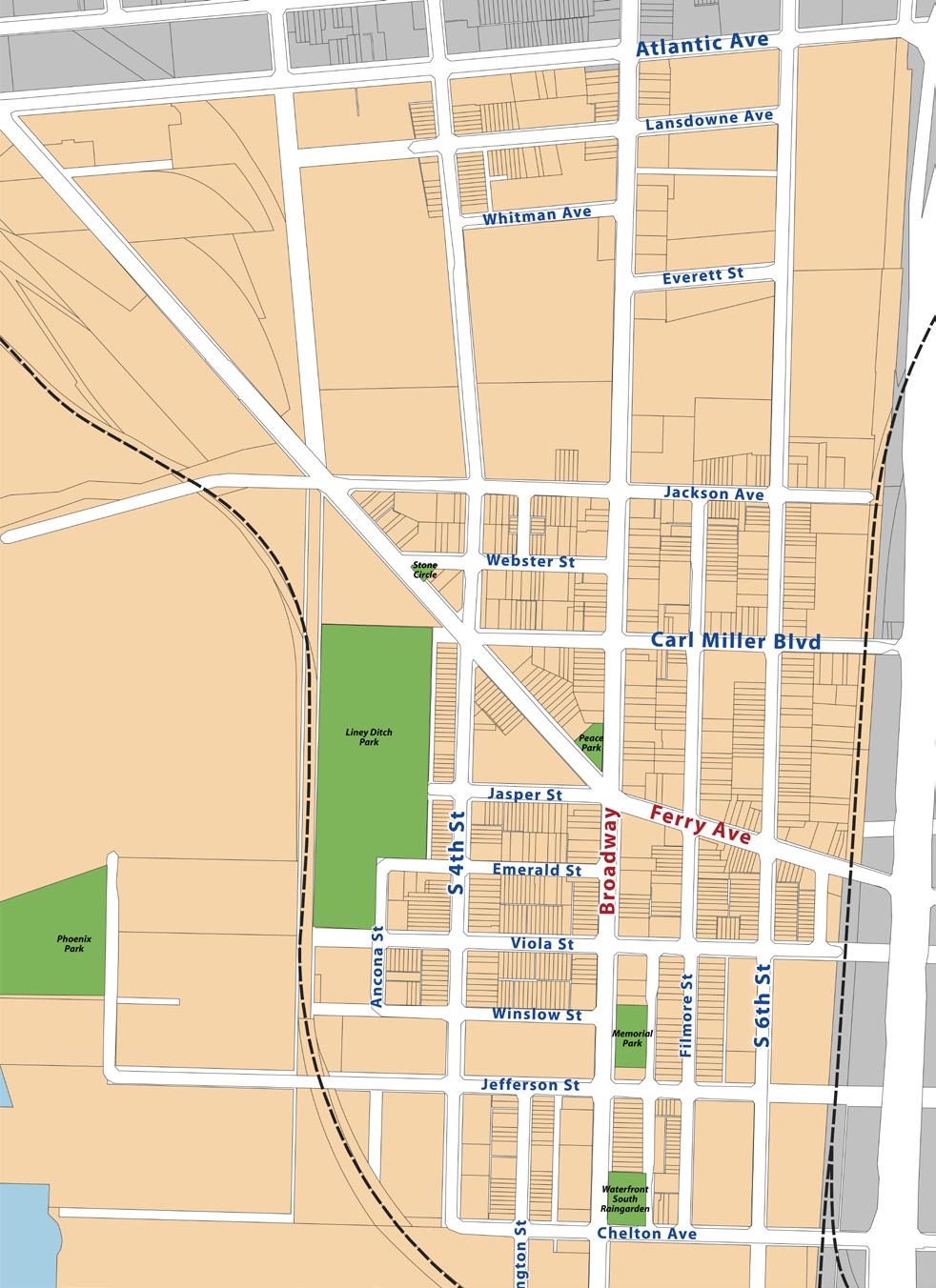
Neighborhood Underpasses
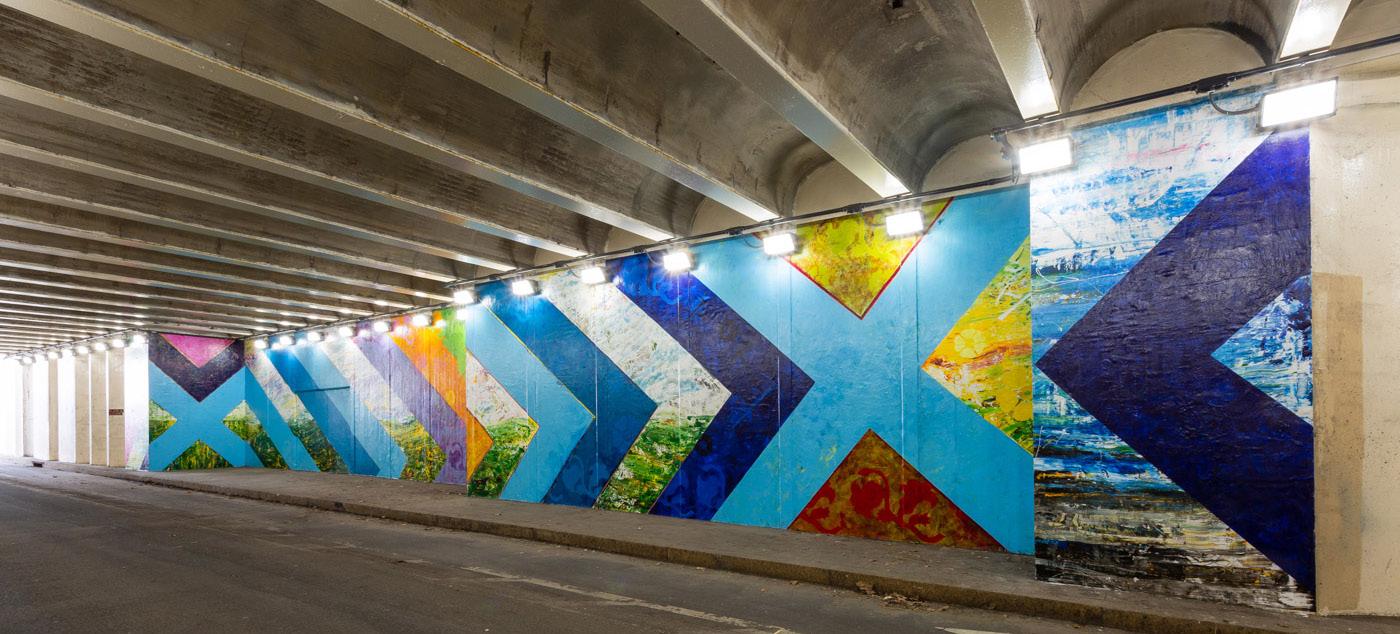
3
Housing Choices
“Housing options in the Camden Housing market are critical to the revitalization of the city and the Waterfront South neighborhood. Camden must compete with the region to sustain and build its market. Options are those of construction type, design, target market while offering Rental and Homeownership opportunities. The Camden Housing market requires a multi-faceted strategy that must include partnerships between the public, private and nonprofit sectors. Camden requires innovation to retain existing residents and attract new ones. We want residents to benefit from the growth in regional housing markets through less deed-restricted housing. As we create a sustainable reality for our community, we need to also ensure that they are sensitive to the health of our environment and end environmental injustices so that the investments our residents make in purchasing homes in our community are a great investment. “

Shaneka Boucher, Waterfront South Resident
A conceptual built-out analysis performed by the planning team indicates that vacant parcels and abandoned structures located within the 25 blocks that form the historic district could yield, if developed
‘by right’ (under the current R-2 zoning district), an additional 300 to 400 new housing units in the neighborhood. That would represent close to a 90% expansion of the housing stock from the current 549 units that exist today. While this is just a hypothetical number disconnected from current market forces and other development parameters, it provides a sense of scale related to housing opportunities associated with vacant land that was previously occupied by homes and the neighborhood’s potential to rebuild its residential fabric within the next ten years.
A variety of strategies will be required to rebuild the neighborhood fabric and expand housing opportunities. The recommendations presented below seek to address the following priorities identified by the community during the planning process: ❱ There is an unmet demand for housing options beyond the typical rowhomes that characterize 90% of the housing stock in the area. Residents reported a lack of housing options for seniors who wish to downsize from their current homes and families who wish to stay in the neighborhood but require more space. Housing choice is, therefore, a top priority for the community, for all income levels and in both ownership and rental options. Over 60% of residents who responded to the community survey expressed interest in purchasing a home in the next three years.
❱ Homeownership preservation ranks as another key community priority to ensure both affordability and the long-term viability of the historic housing stock. Initiatives and programs aimed to assist individual homeowners in their efforts to maintain and upgrade their properties are presented here as key components of a future housing strategy.
Likewise, protecting current homeowners from predatorial wholesale homebuyers is another facet of homeownership preservation.
❱ Local developers, including resident entrepreneurs, have demonstrated interest in acquiring and developing new homes in the neighborhood.
However, tax liens and other legal encumbrances prevent potential investors from acquiring and developing vacant properties. Clearing those properties and bringing them back to use is a third component of the housing strategy guiding future investments.
Legend:

Proposed Light Rail Station
Historic Overlay
Camden Board of Education
Camden Count MUA
Camden Redevelopment Agency City of Camden
Heart of Camden
South Jersey Port Corporation
Private
Building Not Occupied
Building Abandoned
Vacant Lot
Game Changer Opportunity
Rezone for mixed-use development Promote mixed-use along Broadway
Rebuild
Leverage vacant land for infill and redevelopment TOD opportunity
Adaptive Reuse
Strengthen
Rehab Infill Multi-family redevelopment opportunity
The residential core of Waterfront South that lies South of Ferry Avenue includes largely intact blocks of traditional rowhomes. These blocks harbor the rich community and cultural life that make Waterfront South unique within Camden and are predominantly owneroccupied, with limited vacancy. The few scattered vacant homes and lots throughout the area are, however, attractive nuisances, inviting squatters, illegal dumping and irregular activities into an otherwise stable residential area. A concerted effort to tackle these isolated properties through residential rehabilitation and new construction will create new housing opportunities in the area with minimal investment but a positive impact to surrounding homes. A key challenge about redevelopment of vacant properties relate to title and deed issues. While several of these vacant properties are owned by the Heart of Camden or the City, some still remain entangled in private estates and tax delinquencies. To bring these abandoned parcels into the development pipeline, a coordinated effort with the City will be required to identify and resolve ownership and tax lien issues. New homes in this area will certainly address the unmet demand for ownership and rental housing, creating an excellent opportunity for near term development projects that will further strengthen the neighborhood and expand the residential base. Key strategies to achieve this goal include: a. Create new homeownership opportunities through rehab and new construction New homeownership opportunities will be a critical component of a housing strategy south of Ferry Avenue. Combined, properties owned by the City and Heart of Camden provide an excellent opportunity to jump start an early development phase. The Heart of Camden anticipates a near term development of up to 39 new construction and rehab units targeted for affordable homeownership within the neighborhood residential core. Funding will draw from a combination of City and corporate grants, Neighborhood Revitalization Tax Credit funds, Historic Tax Credit funds and construction loans. Development in this area should focus on fostering equity and opportunities to build wealth locally. Developer assistance programs such as Jump Start Philly provide a model for local partnerships, expanding development opportunities to small developers and local entrepreneurs.
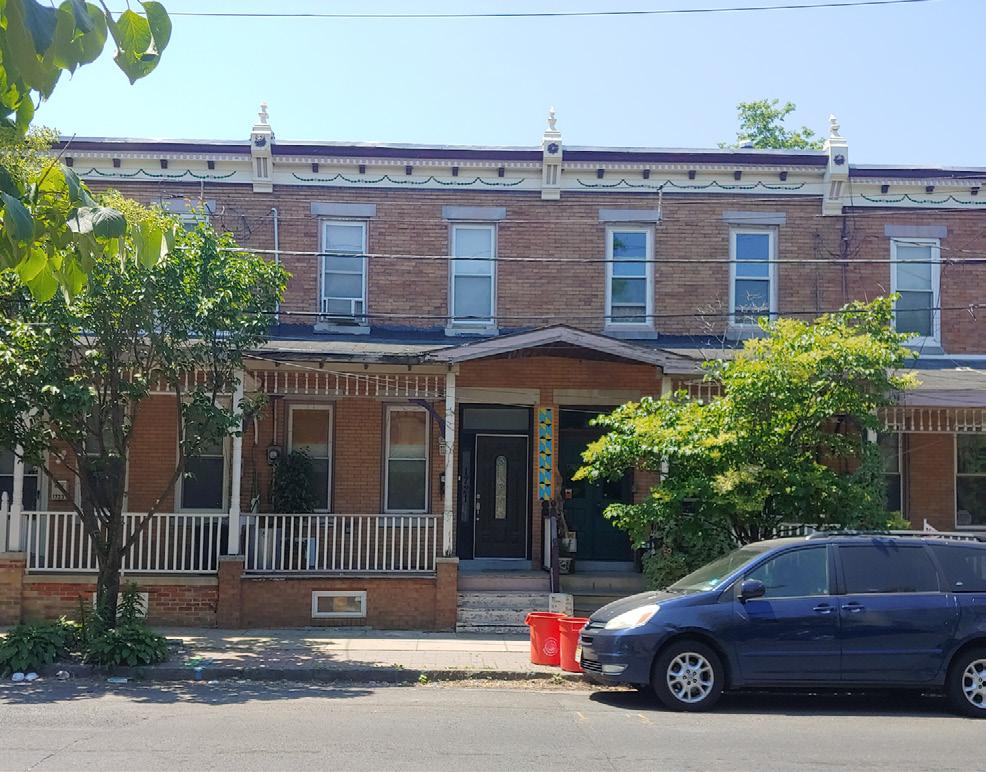
Solid block housing: Ferry Ave
Jump Start Philadelphia
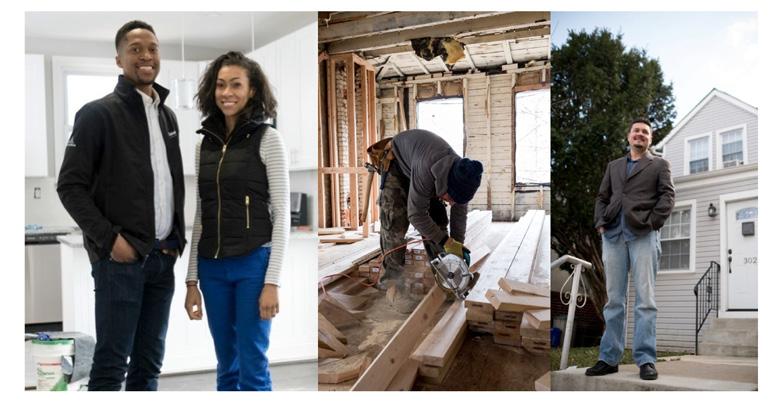
Jump Start Philly, sponsored by Philly Office Retail a community focused real estate company, partners with local non-profits and the Philadelphia Housing Authority to support aspiring developers and create opportunities for residents to invest and develop in their own neighborhoods. The program offers a combination of training, networking, and loans to finance the acquisition and renovation of residential properties. Short term loans are available for up to 85% of total project cost in qualified areas of the city. Properties are made available to investors via a lottery administered by the Housing Authority.
b. Assist current homeowners with essential home repairs and upgrades Most of the homes in Waterfront South are within the historic district and nearly 60% of them are over 100 years old, dating back to the late 19th and early 20th centuries. Older homes require significant and costly maintenance. They tend to also have outdated systems and are not energy efficient. Programs and funding to help homeowners upgrade systems and make basic repairs already exist in Camden and have demonstrated successful results in upgrading the local housing stock, one property at a time. The ‘My Home’ program administered by St Joseph’s Carpenters Society in East Camden provides a good example of a local program that assists low-income homeowners with essential repairs and helps preserve equity in their homes. Although home repair programs target primarily life and safety improvements, a closer look at the specific needs of the Waterfront South will help tailor the program to include additional items such as porch lights and sidewalk repairs.
c. Support renter residents who wish to purchase a home in the neighborhood Current residents who wish to become homeowners have struggled to find housing available to purchase in the neighborhood. Keeping residents with community ties in Waterfront South is a critical step in reversing decades of population decline. In addition to improved access to affordably priced for-sale homes, residents can also benefit from connections to lending institutions and homeownership literacy programs such as the Homeowner Academy operated by St Joseph’s Carpenter Society in East Camden. The program provides financial literacy training and assists residents who wish to become homeowners in their journey through the process.
d. Partner with corporate neighbors to establish a local homeownership assistance program At one time, Waterfront South was a community deeply connected to local employment with much of the neighborhoods’ workforce connected to jobs in the shipyards and other maritime industry along the waterfront. While the nature of employment today is not as hyperlocal as it was a century ago, there is an opportunity for larger employers such as EMR, South Jersey Port Authority and Holtec to assist employees with down payment assistance and other incentives towards the purchase of homes in the Waterfront South.
e. Promote Adopt-a-lot program for nondevelopable vacant lots Some vacant parcels in the neighborhood may not be appropriate for new construction due to size or orientation. In such cases, the City’s Adopt-a-lot program provides adjacent property owners the opportunity to acquire the parcel at minimal costs for use as an open space or off-street parking. Residents who tried to engage in this program in the past have reported that challenges with deed transfer and costly property insurance requirements inhibit broader participation in the program. City assistance to streamline this process will empower residents to reclaim and repurpose vacant lots while enhancing the physical and safety character of residential blocks.
f. Redevelop the former Croft Mills site as an anchor mixed-use development The Croft Mills property provides a unique opportunity to anchor the Broadway corridor in Waterfront South with a new residential/mixed-use development project. The full block site is currently vacant and could accommodate a sizable multi-family housing development. Located on Broadway and with direct access to bus lines and neighborhood services, the site can provide an ideal opportunity for senior housing. New and affordable senior housing will help retain residents in the community as their housing needs change and release existing housing stock for new families.
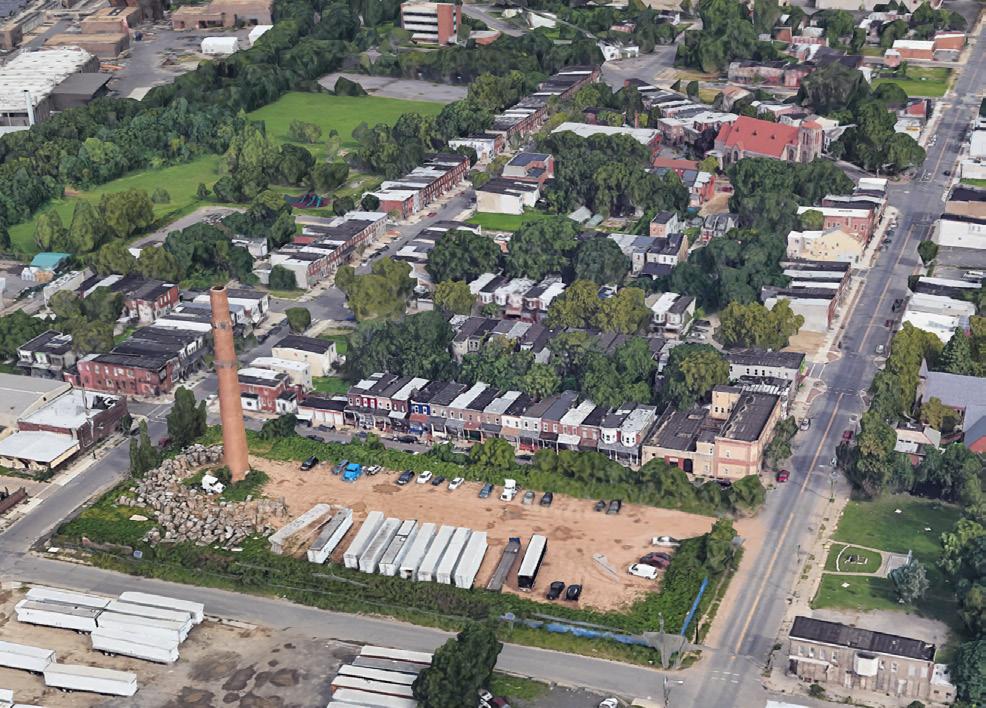
3.2 Rebuild residential blocks with high vacancy
While the residential fabric south of Ferry Avenue is largely intact and will benefit from targeted infill and stabilization efforts, the blocks north of Ferry provide an opportunity for more significant redevelopment, expanding the residential base of Waterfront South and attracting new residents who will support local businesses and organizations. The area is currently characterized by significant vacancy and a concentration of city-owned parcels, some of which are slated for the future light rail stop proposed on Ferry Avenue. Future redevelopment initiatives in that section of the neighborhood will require a comprehensive land acquisition and consolidation effort. The following strategies will help advance the goal of restoring residential blocks north of Ferry Avenue:
a. Identify mechanisms for land assembly and potential partnerships for redevelopment A partnership between the City and potential development partners will be required to generate meaningful redevelopment opportunities north of Ferry Avenue. While the City will take the lead in land acquisition and assembly efforts, private investment coupled with multiple funding opportunities will be required to realize the potential of these properties as mixed-income housing options. In order to facilitate development in this area, potential development partners should be identified based on performance record and with a commitment to sustainable and equitable development. b. Prioritize mixed-use development along Broadway The process of restoring residential blocks north of Ferry Avenue should include a careful approach to the Broadway corridor. Resident surveys and discussions indicate the desire to see a variety of housing options along the avenue, combined with ground floor retail, services or community spaces. Live / work solutions, mixed-use multifamily apartment buildings and traditional apartments above shops were some of the housing typologies identified by the community as appropriate solutions for the corridor.
c. Redevelop the former Mickle School building for housing and mixed-use The former Mickle School building at the corner of 6th Street and Carl Miller Boulevard can be a catalyst project, anchoring development north of Ferry Ave. The adaptive reuse of this historic school structure can accommodate unmet housing needs such as special needs or artist work/live apartment, along with other neighborhood related uses.
Heart of Camden Housing Priorities for the next 5 Years
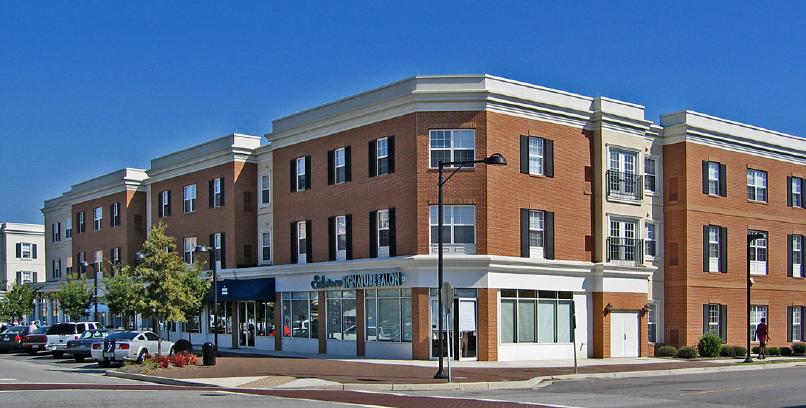
Rehabilitation Homeownership 40 Units New Construction Homeownership 20 Units Rental 40 Units Total Units 100 Units
Example of mixed-use buildings with ground floor commercial space and upper floor residential units.

d. Leverage future transit investments for a transit-oriented development Plans for the future Camden-Glassboro light rail line anticipate the location of a station in the neighborhood, between Carl Miller Blvd and Jackson Avenue just west of the I-676 underpass. The extension of light rail service to Waterfront South provides a unique opportunity for a gateway development anchoring the residential core with higher density, mixed-income and mixeduse development. A mix of uses can bring jobs, new programs and services to the neighborhood, coupled with higher density housing options. In anticipation of the new transit amenity, careful consideration should be given to zoning and development standards surrounding the proposed station and forward efforts at land assembly and lot consolidation.
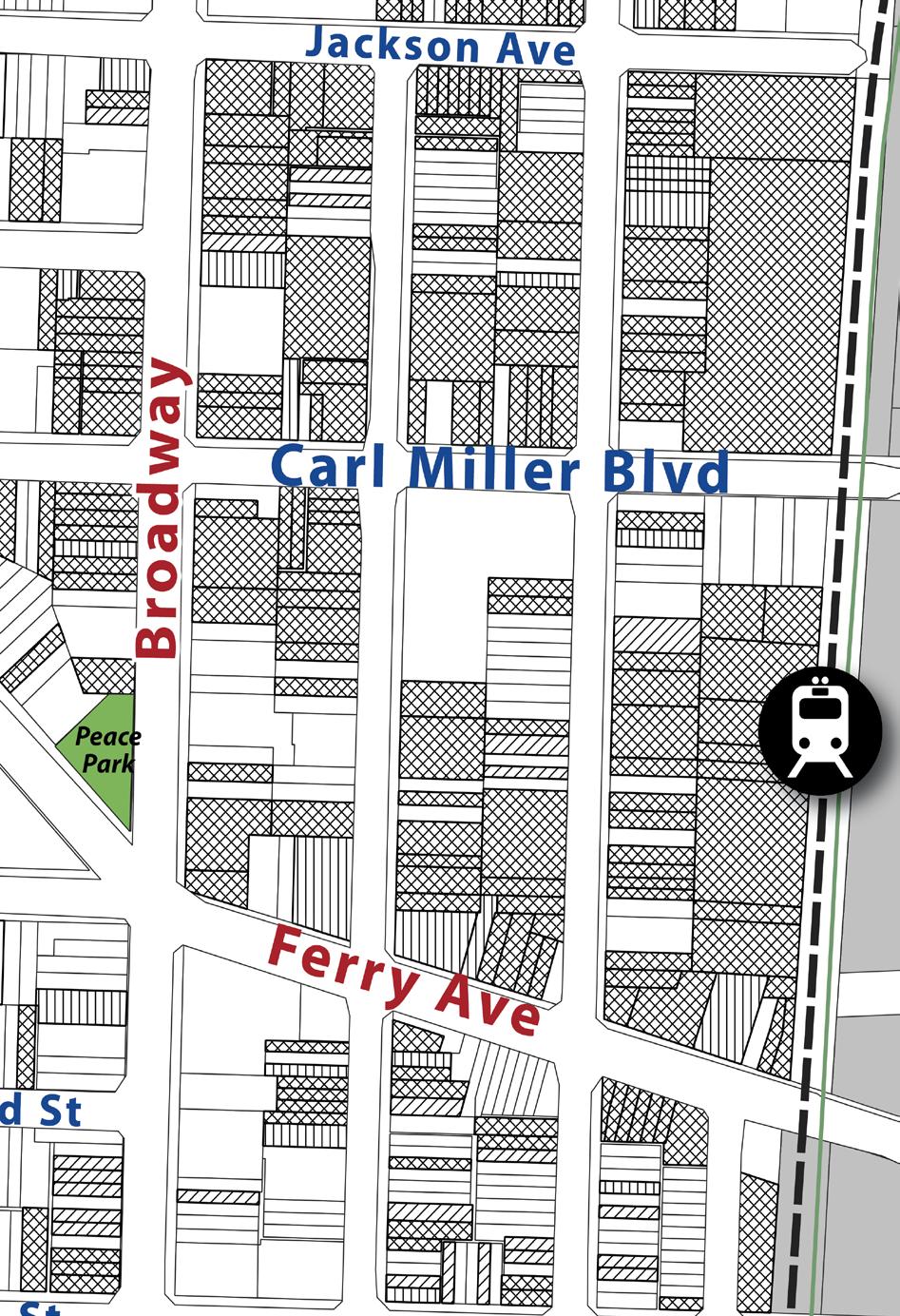

Example of Transit Oriented Development
Atlantic Ave
Lansdowne Ave
Whitman Ave
S 4th St Broadway Everett St
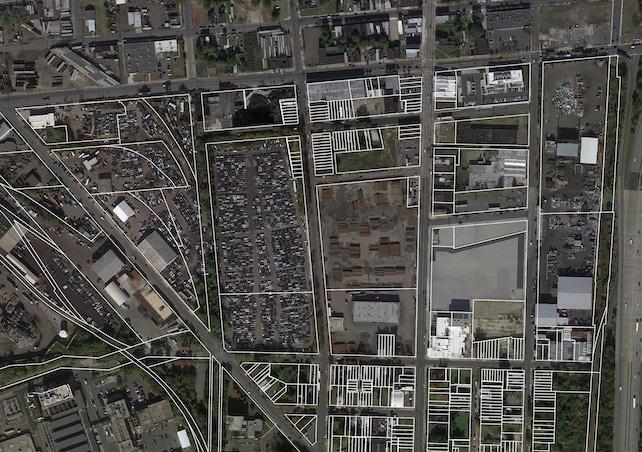
S 6th St
Ferry Ave Webster St Jackson St
Waterfront South aerial between Atlantic Ave and Jackson St
Legend:
Proposed Light Rail Station Building Abandoned
Building Not Occupied Vacant Lot
Extensive land availability along the north-eastern end of the neighorhood provides an opportunity provide an opportunity for a transit oriented development
A Game Changer Opportunity!
While neighborhood blocks between Jackson Street and Atlantic Avenue are primarily industrial in use, the opportunity to reclaim that area as an extension of the neighborhood fabric should be looked at as a future goal for the community, should current businesses choose to relocate, and properties be available for sale. The future light rail station serving the neighborhood and increased housing demand are key factors driving that potential. Moreover, as described on Priority 9, a reimagined Atlantic Avenue that serves as a City gateway can reinforce opportunities for commercial uses and services and help establish that area as a mixed-use zone promoting commercial and residential uses. Rezoning of properties along Broadway, between Atlantic and Everett will allow for a broader variety of uses.
4
Safe and Clean Streets
Waterfront South’s residential blocks are typically well kept with street trees, rain gardens and public art showing layers of care and investment by residents and community groups who have worked to improve the community over the past several decades. Residents look out for one another and generally feel safe in their homes and on the blocks where they live. However, public safety and clean streets remain priorities as the community struggles to manage the impact of the dual overburdening of concentrated social services that serve mostly non-city residents, high-impact industrial uses, dangerous truck traffic, and increased prostitution and drug activity that follow such truck routes. Decades of limited City services and deferred maintenance have left the appearance of disinvestment in much of the public realm and limited enforcement of codes and regulations have enabled some commercial interests to neglect property maintenance standards. At night, as in much of Camden, streets are dark, and vacant lots and buildings provide cover for illegal dumping and illicit activity.

Enhanced lighting is critical to improving public safety in Waterfront South. Community members currently feel far less safe at night than during daylight hours. Street lighting in the community is insufficient with many of the limited number of streetlights not operational. While repairing and expanding street lighting is a critical step, additional illumination can be provided by incentivizing the installation of exterior lights on residential porches and public building facades. Beyond illuminating dark streets public safety will be increased through enhanced communication with the Camden County Police and continued support of DCCB’s efforts to support neighborhood safety. A regular schedule of community cleanups will assist in keeping neighborhood streets clean and build community through the coordinated work of community groups and block leaders. While residents are able to assume responsibility for keeping their own blocks free of trash and litter expanding the operations of Camden Special Services District, already active in the area around Holtec, can provide critical support towards cleaning major corridors and deterring short dumping. Securing vacant lots and installing cameras at critical locations is another important step in eliminating the illegal dumping that burdens Waterfront South with refuse originating elsewhere. Businesses and industrial uses should also be expected to do their part to keep their neighborhood clean by implementing improved property management and remaining aware of their residential neighbors and location within an urban community.
4.1 Improve neighborhood lighting conditions
Research shows that lighting improvements in residential neighborhoods have a positive impact in crime reduction. Well-lit streets inhibit crime activity by making areas more visible to neighbors and police, and encourages people to spend more time outside, thereby increasing movement and informal surveillance. Three measures will help improve lighting conditions in Waterfront South:
a. Street lighting: The District Council Collaborative Board (DCCB) has been a critical partner of the Waterfront South community in the effort to improve lighting conditions. In collaboration with residents and the CCPD, DCCB completed a comprehensive street lighting assessment in 2021, reporting outages and identifying areas where new lighting is needed. Conversations with resident indicated the areas around 6th street, Filmore and Viola as areas of concern. Parks and pedestrian connections to parks were also identified as places where residents feel unsafe due to limiting lighting.
b. Porch lights: DCCB has also started a porch light campaign to encourage residents to keep their porch lights on at night as an additional lighting and safety measure. The campaign assists residents with energy efficient light bulbs and installation of porch light fixtures. This effort was initiated in the past year and will have a positive impact with additional funding and assistance to DCCB in their outreach efforts.
c. Exterior lighting at public buildings:
Another measure to help enhance lighting in the neighborhood includes exterior lighting at public buildings. Structures like schools, churches and community buildings can help improve safety through lighting installation on building facades. As a historic district with wonderful examples of historic structures, enhanced lighting on individual buildings will also help highlight these special neighborhood assets and beautify their areas. Buildings on Broadway like the Heart of Camden, FireWorks, churches and the old bank building can be targeted for that initiative.

Facade lighting Philadelphia
A recurring topic in conversations with the community about public safety relates to lack of clarity among residents about ways to communicate and report incidents to the CCPD. Although CCPD makes multiple channels available for reporting, there is confusion about the proper use of each channel, especially when it comes to the use of online tools and smart phone applications. Residents have also reported hesitancy in calling the police with concerns about potential implications to themselves, family members or neighbors. At the same time, CCPD reports that call data helps determine the assignment of officers throughout the City, so residents are encouraged to call if they would like to have a certain level of police presence in the neighborhood. A concerted communication campaign from CCPD can help address these issues. Although the police participates in monthly meetings and makes itself available for questions and updates, information shared at meetings does not reach all residents. Additional coordination with HOC and local resident groups can help the CCPD disseminate information about reporting tools. Information sessions, informational materials distributed at community events and door-to-door outreach can help maximize CCPD’s reach and impact.
4.3 Support DCCB’s efforts in the neighborhood
District Council Collaborative (DCCB) has been supporting neighborhood safety efforts in Waterfront South community since 2019. Along with the Camden County Police Department, DCCB is a critical neighborhood partner, helping residents identify concrete solutions to improve safety in the community. Several community meetings were held to date, both in-person and remote, helping identify neighborhood challenges around public safety and actionable steps to address those challenges. The street lighting campaign is the first of those steps. Future initiatives include a porch light program and the development of a block captain system.
4.4 Expand Camden Special Services District’s presence in the neighborhood
Through their Clean and Safe Program, the Camden Special Services District (CSSD) provides street maintenance services in various sections of the City. Beyond downtown Camden, CSSD ambassadors (known around town as ‘yellow-jackets’) also serve neighborhood corridors, parks and other public spaces. Although they are solely responsible for street maintenance, the ambassadors’ regular presence on the streets ensures a safer and welcoming environment. CSSD already serves the area around Holtec in Waterfront South. Expanding these services to Broadway and Ferry Avenue is a natural next step, benefiting both businesses and residents. A partnership between CSSD and local industrial businesses can help create a dedicated funding stream to support services. CSSD is also dedicated to hiring Camden residents, so the initiative can also help secure employment opportunities for Waterfront South residents as local CSSD ambassadors in the neighborhood. 4.5 Establish a neighborhood cleanup program targeting residential blocks
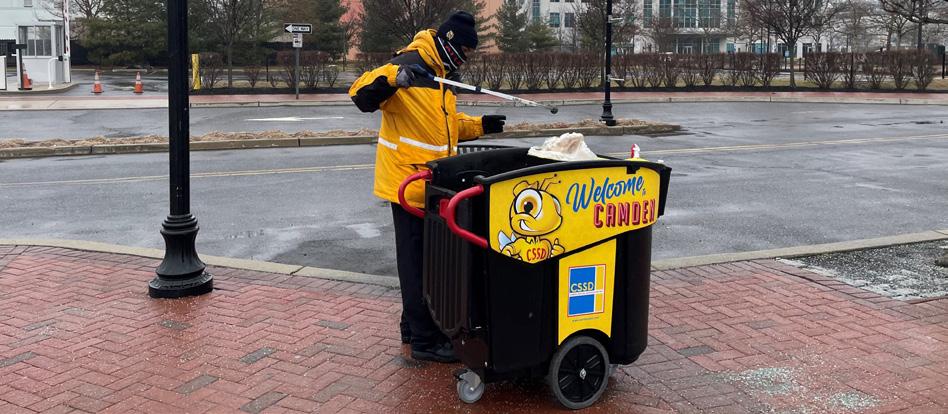
Beyond Broadway and Ferry, residents and community organizations can organize to establish a neighborhood cleanup program addressing trash and clutter on residential streets and public spaces. As a compact community of 25 residential blocks, a collective community effort can be a manageable initiative to keep streets, parks and residential front yards clean and well maintained. A cleanup program can include two levels of neighborhood efforts:
❱ Connect residents to City resources and advocate for City services. Local resident groups can lead a campaign to provide residents with trash cans and recycling bins that comply with City requirements while also advocating for consistency in trash removal and recycling. An effort to establish a direct channel of communication with DPW will help address City services and code enforcement regarding property maintenance.
❱ Neighborhood wide efforts can be initiated by a central organizing group (local organizations, resident groups) and focused on a schedule of seasonal clean up events targeting parks and public spaces.
Neighborhood clean-ups require significant planning, coordination, outreach and supplies. An ongoing partnership with the City and businesses can help support these activities.
❱ Block level efforts can be initiated by block residents and target the clean up of individual blocks. Block cleanup efforts can be done more regularly as they require coordination primarily between same block residents. Block efforts provide a great opportunity for neighbors to meet and come together around shared goals. New community leadership can also emerge from these activities and can lead, on the long-term, to the establishment of a block captain / block ambassador program. Micro-grants can be made available to block groups as incentives towards beautification projects.
4.6 Maintain and secure vacant lots
While residents can help maintain their properties and streets clean, maintenance of vacant lots falls within individual owners’ and, ultimately, in the case of absentee owners, the City’s responsibility. The upkeep of vacant lots is an important component of a safe and clean neighborhood program and requires consistent efforts to clear overgrown vegetation, remove trash and litter. Given the magnitude of vacant properties in the Waterfront South, priority should be placed on infill lots between occupied homes.
4.7 Address illegal dumping
The City of Camden is aggressively working to address illegal dumping, a problem that has challenged Camden neighborhoods for decades. In Waterfront South, this problem is amplified by the extensive amount of vacant land and underutilized industrial sites. To address this issue, the City has recently secured funding for the installation of cameras at illegal dumping sites. Waterfront South is a natural candidate for one or more cameras at most critical sites to be identified by the community. Another important step in the process of eliminating illegal dumping is to disseminate information to residents about ways to report illegal dumping events. Information should be shared at public meetings, social media, posters and fliers.
4.8 Enforce property maintenance by local businesses and industrial uses
Proper upkeep of industrial properties should be an integral component of a clean and safe neighborhood program. Large industrial sites with extensive stretches of unkept land have been reported by community members and contribute to amplify an already challenging task to keep the neighborhood clean. Issues like litter and overgrown vegetation should be regularly addressed. A possible way to monitor and encourage businesses to do their part as neighbors is to establish a direct channel of communication between the community and industrial businesses to report trash and maintenance issues.
Did you know?
Did you know that ILLEGAL DUMPING can be reported anonymously online through Camden Reports?
https://www.camdenreports.com/dumping-form

4th & Winslow St illegal dumping
4.9 Address irregular activity by truck drivers
Beyond the environmental hazards and safety risks they bring to the neighborhood, truck traffic adds 4th and Winslow St illegal dumping an additional layer of safety issues and nuisance experienced by residents with contracted truck drivers who solicit prostitutes on residential streets and feed into the drug activity taking place in the area. Industrial businesses should have an active role in addressing this issue with initiatives to discourage irregular behavior.
Philadelphia More Beautiful Committee
This program works with registered block captains to keep City blocks clean. The committee promotes and organizes clean up events, provides block captains with cleaning tools and with information and guidance, in support of volunteer block captains.
5
Economic Growth and Opportunity
“Cultural projects are not simply a luxury but play a fundamental role in reviving the fortunes and boosting the prospects of minority and other disadvantaged communities. When people become involved in the design, creation, and upkeep of places, they develop a vested interest in using and maintaining these spaces. When they have a true sense of “ownership” or connection to the places they frequent, the community becomes a better place to live, work, and visit. The residents’ feelings of respect and responsibility for the place bonds them to that place and to each other.“
Robert Bingaman, Waterfront South Arts & Cultural Alliance

A vision for economic development and opportunity builds on the unique assets of Waterfront South to revitalize Broadway as a thriving commercial corridor, attract new investments to the neighborhood and connect residents to economic opportunity.
The cluster of arts and culture groups, along with neighborhood parks and industrial businesses generate opportunities for the neighborhood as drivers of economic development. Arts and culture, along with parks, can help define the neighborhood’s unique identity in the City and region, drawing visitors and generating additional demand for businesses and services. Industrial businesses can help expand local employment opportunities, support training and professional development while also creating demand for local retail and services on Broadway.
The following recommendations leverage community resources to promote the neighborhood’s identity as a hands-on community seeking to restore its economic vitality through the creativity, skills and resources of its people combined with positive partnerships leading to jobs and entrepreneurship opportunities. A focus on green light-industrial economy as a new economic engine makes up the third pillar of the economic strategy guiding investments in the next ten years.
5.1 Leverage arts & culture as an engine for economic development
The six Waterfront South arts and cultural organizations are unique assets in the City of Camden. Clustered in the neighborhood core, they form a strong pillar for future growth and economic development. The following strategies will help solidify the neighborhood’s potential as an art and culture district:
a. Seek designation as an Arts and Culture District. A first step in solidifying the neighborhood’s identity includes the City’s recognition and designation as an arts and culture district.
b. Host annual citywide arts & cultural event, inviting artists from the City to showcase Camden’s work and talent. Seasonal events anchored by local arts and culture groups will put the neighborhood on the map of regional events, highlight Camden’s arts scene, and reinforce the neighborhood identity as an arts district.
c. Identify and recruit new arts and culture partners to locate in the neighborhood. Proximity to the existing cluster of organizations can help attract new creative groups and businesses to Waterfront South. A concerted campaign led by the Waterfront South arts and culture community with support from Heart of Camden and the City should be considered to identify and market existing structures within the neighborhood with potential for rehabilitation or conversion into new offices and art studios.
d. Promote the creative economy with artist housing and/or spaces and infrastructure that support small-scale manufacturing and artistic endeavors. Recent efforts by local groups to coalesce around shared goals and improve collaboration can expand their opportunities for funding and expanded capacity. A new staff position within that coalition to oversee and coordinate collective initiatives will be a critical step to bring projects to fruition. e. Promote the creative economy with spaces and infrastructure that support small-scale manufacturing and artistic endeavors. There is a growing interest from residents and local groups to establish a flexible makers’ space in support of local residents’ initiatives and collaborative efforts between organizations. A local makers space can provide the space for people to produce and sell their own goods and attract artisans, micro and small-scale manufacturing businesses that benefit from a collaborative environment and proximity to highways and the region for supplies and distribution. A makers space on Broadway, right at the heart of the neighborhood, can be a strong catalyst for economic development and help develop a niche demand for services and retail spaces along the corridor. A few spaces were identified by the community as potential location for that type of facility. Some of the historic structures on the avenue, such as the old Bank Building and the Olsen Hardware store could be good contenders for such uses. The bank building is currently owned by Holy Bethel Pentecostal Temple. A closer understanding of their use of the space along with future plans could help identify opportunities for partial use of the space.

A first step in support of a makers initiative includes further explorations with the community and a closer understanding of the steps required to create a community makers space. Nation of Makers, a national organization aimed to support the maker movement, can provide initial guidance in that direction.
5.2 Re-imagine Broadway as a thriving mixed-use corridor “Commercial corridors have a crucial role in building healthy vibrant communities. They are not just places where local residents shop and gather, but places where people build wealth through small businesses, find jobs, and share, celebrate and preserve community culture.”
A series of incremental initiatives and targeted investments will help restore Broadway as a commercial corridor and focal point of community life. Efforts described under Priority 2 to maintain a clean and safe corridor will enable residents and local organizations to re-imagine possibilities for short-term and long-term interventions targeting the core stretch of the corridor, between Jefferson and Jackson streets.
a.Promote mixed-use development through rehabilitation and new construction Broadway’s revitalization provides an opportunity to explore mixed-use development opportunities that emphasize housing, services and commercial spaces as critical components for a successful corridor. New housing opportunities along the avenue can help attract new residents to the neighborhood and steadily build the critical mass required to support the types of businesses and services that make up a healthy community. Housing, in particular, was identified as a top priority for future development, with emphasis on small units and creative work-live arrangements. Partnerships with small developers can help identify small mixed-use development opportunities between Jackson and Jefferson that match the scale of the neighborhood as 2 to 3-story structures with new storefront opportunities, flexible living/working arrangements and upper floor residential uses.
ARTeriors Ocean Ave Gallery in Atlantic CIty is a community art project inviting local artists to reimagine the spaces of an abandoned home in the neighborhood. The resulting work was open for public visitation during the Summer of 2021. Source: Atlantic City Arts Foundation77
b. Target the preservation and rehabilitation of historic structures as neighborhood assets and anchors on the Broadway corridor Past efforts by the Heart of Camden and City of Camden to rehabilitate historic neighborhood structures have been critical components of the neighborhood’s revitalization. In the next 10 years, efforts should be made to preserve and repurpose the Olsen Hardware store and Bank Building. A variety of State programs coordinated by New Jersey Historic Trust can help advance these projects with funding through grants and loans.

c. Promote streetscape improvements, placemaking and beautification projects A partnership with the local arts and cultural community can help establish a creative, hands-on, community-based approach to streetscape and placemaking initiatives along the corridor. Artists and residents can come together to re-energize the avenue with public art installations, sculptures and seasonal interventions on vacant structures and empty lots that reflect the neighborhood’s character. Signage with markers for historic structures, banners and wayfinding are additional components of a successful strategy. There is already a solid public art tradition in the neighborhood. Building on that experience can help define the character Broadway’s character as a live ‘community art gallery’ and a place for creative expression.
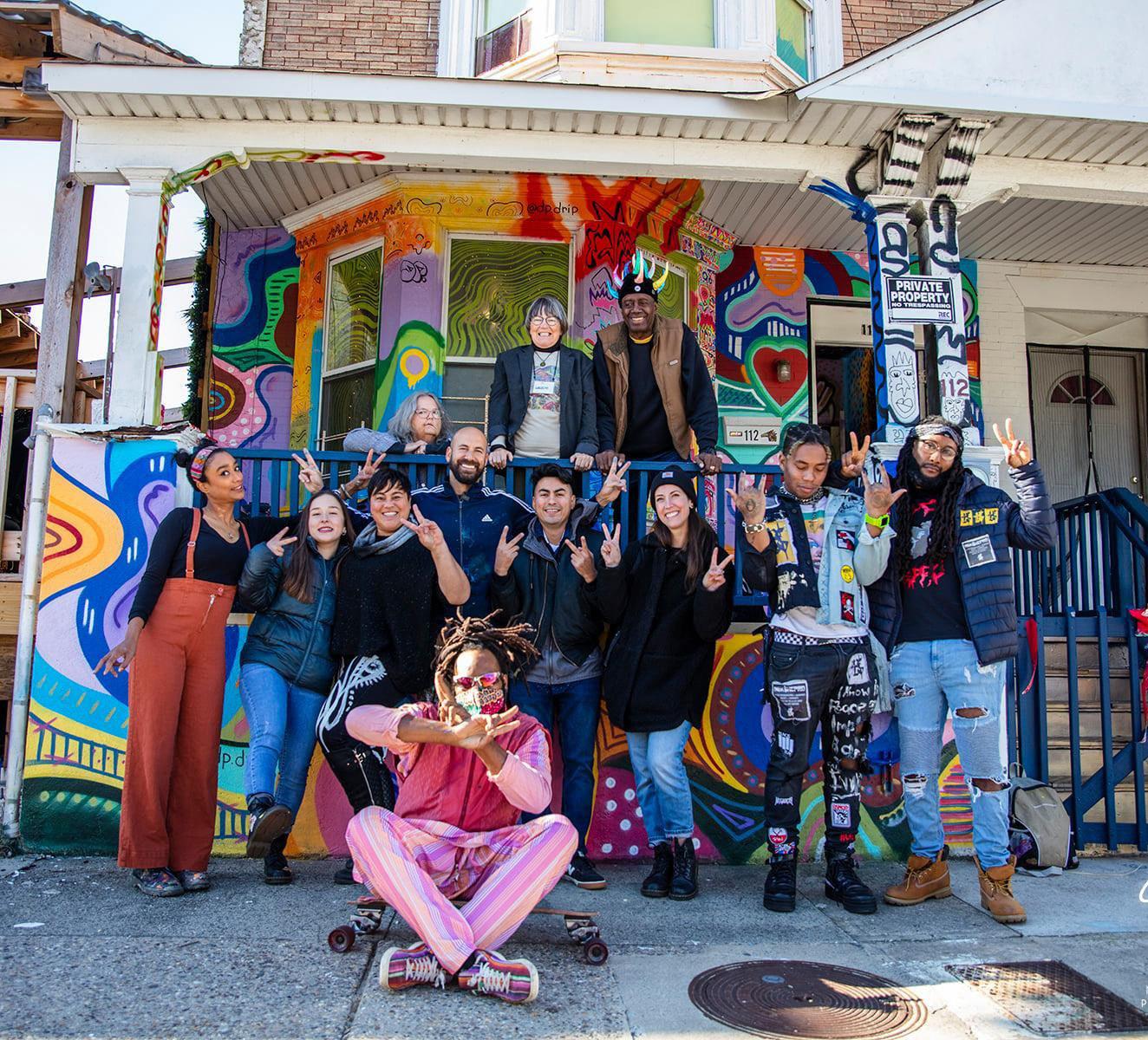
d. Identify partnerships for essential community services along the corridor Residents reported that basic services are, for the most part, met outside of the community. This pattern especially impacts residents who do not own a car and who rely on transit or rides from family and friends for essential shopping and services. Results from the resident survey indicate the following types of businesses and services residents would like to see in the neighborhood:
❱ Laundromat ❱ Convenience store ❱ Small grocery store ❱ Fresh food stand ❱ Clothing store ❱ Medical offices ❱ Hair salon ❱ Restaurants ❱ Coffee shop ❱ Gym and fitness center
While current demand generated by residents may be insufficient to support brick and mortar investments for some of these services, partnerships with existing businesses in the City can help create pop-up events bringing services to the neighborhood in coordination with neighborhood events. Food trucks can be brought during theater days and groceries can be made available via Virtua’s Mobile Grocery Store. Essential and medical services can also be connected via mobile services.
5.3 Promote local jobs and small business opportunities a. Connect residents to local job opportunities ❱ Partner with local employers for local training and employment opportunities
❱ Expand access to City employment resources including Camden Works, community job fairs and
b. Connect residents to entrepreneurship programs ❱ Partner with LAEDA for training program
❱ Create jobs within the neighborhood
c. Invest in minority and women owned businesses ❱ Identify local financial partners as investors in inclusive growth
❱ Identify service providers with programs tailored to
MWBE businesses
❱ Identify grants and other funding opportunities in support of start-up MWBE businesses
5.4 Seek partnerships with local institutions for non-industrial uses
Camden has a wealth of institutions with ambitious expansion plans and space needs that may exceed their existing footprints. Rutgers University, Cooper and Virtua hospitals, Camden County College are some of these institutions with potential requirements for additional spaces and satellite locations. Waterfront South can provide a desirable option due to proximity to downtown, highway and future light rail
A Game Changer Opportunity!
Waterfront South is uniquely positioned in Camden and, perhaps in the region, to develop a new type of industrial economy that focuses on reduced carbon emissions, energy efficiency and zero impact to the environment. While existing companies located in the economic zone advance goals to minimize their environmental footprint, a focus on Green Entrepreneurship and Sustainable Business Practices can help transform the area’s identity attracting businesses that, by nature of their own activities, advance sustainability goals with the well-being of people and communities as primary priorities. A green economy can help redefine the Waterfront South economic zone as a GREEN economic zone and, on the long term, shift Camden’s identity from a legacy industrial city to a forward looking green, resilient and sustainable community.
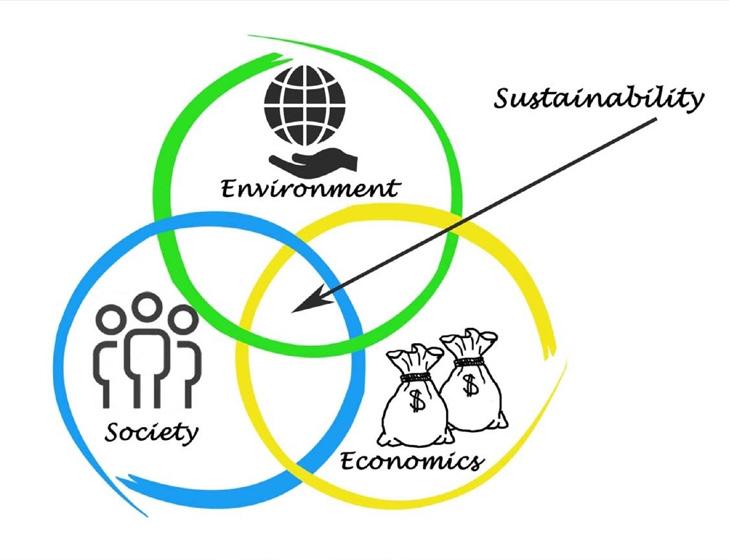
Green Economy Image
6
Community Amenities and Services
“Green Space is vital to the quality of life for the residents of our city. Cities were not built for people; they were built for commerce. Nothing nutritional or life sustaining grows from cement and asphalt. I believe that every little tree, bush and plant enhances not only the air quality but also the aesthetics of the city. I encourage everyone to plant something even if it is in a small container. There is something about watching things grow that brings joy. I have begun planning a pollinator garden for my block. That green space will benefit my neighbors as well as birds and butterflies.” Portia Simmons, Waterfront South Resident
In the past twenty years, investments in Waterfront South helped build the infrastructure required to support community. Between new and improved parks and the emergence of several community and arts organizations, Waterfront South has developed an excellent network of amenities and services. The following strategies will leverage local neighborhood assets for community development, through placemaking, arts, cultural and educational opportunities. A special emphasis is placed on young residents through leadership, recreation, and development initiatives and on opportunities to maximize the use of neighborhood facilities, whether they be community buildings or parks, to meet the community needs. Strategies for enhanced community connections and improved access to services are also included. Community spaces and parks can be employed to highlight the neighborhood identity, promote community and improve access to family services.

6.1 Leverage local arts & cultural assets for community development a. Partnerships for placemaking projects Local arts and community groups will be key community partners in future placemaking, beautification, and wayfinding initiatives aimed to improve Waterfront South’s public realm. Individually or collectively, they can help lead the creative process around placemaking projects and facilitate the dialogue between artists and the community during design and implementation efforts. Local arts groups can also help identify potential funding opportunities for such projects. The following projects described in different sections of the plan are good contenders for such partnerships:
❱ Underpass gateway projects (Priority 4) ❱ Gardening and front yard projects (Priority 4) ❱ Broadway beautification projects (Priority 5) ❱ Redevelop boarded up and vacant buildings near Broadway as artist live-work spaces (Priority 5) ❱ Public art installations in the arts and culture district which can expand outward as funding allows (Priority 5) ❱ Connections to the waterfront (Priority 7)
b. Partnerships for community arts and culture Beyond placemaking initiatives, local arts and culture groups can also leverage their spaces and resources towards programming for local residents:
❱ Children and youth focused programs, including art related workshops and summer camps ❱ Work with community groups to identify inclusive programming opportunities ❱ Schedule events at times that work for residents
6.2 Support and celebrate neighborhood youth
Waterfront South is a young community with 31.9% of residents under 20 years of age. Community conversations during the planning process suggested a scarcity of options for young residents in the area and the need to connect them to opportunities in the City and region. The following strategies can help address these needs:
a. Establish a youth leadership group to help inform and implement future community projects An organized youth group will provide young residents the opportunity to develop leadership skills while actively participating in their community. A local youth group can tackle community projects in partnership and with guidance from local leaders. The group can have an advisory role and serve as a bridge to connect local youth to services and programs in the city and region. MJD Fieldhouse and CSS are critical parties in the process of creating this group. b. Expand youth programs at existing neighborhood facilities The MJD Fieldhouse is a valuable community space and the main venue for youth activity in the neighborhood. The space has the potential to become a hub for local youth programs with extended hours and expanded opportunities. After school programs and summer camps are just some examples of additional opportunities to be explored in partnership with local organizations in the City and region. Arts and culture groups in Waterfront South provide a unique opportunity for youth development programming. Coordinated efforts between these groups and the youth leadership group will help develop programming that will engage the areas youth. The Museum initiative includes the development of a multi-purpose vocational training facility housing a variety of programs in partnership with local organizations. Current plans include workshop space and classrooms serving the Carpenters Union PreApprenticeship program, movie set development and other initiatives in collaboration with Urban BoatWorks and Camden FireWorks. The Museum initiative exemplifies the creative re-use of one of the neighborhood’s most significant structures, the Church of Our Savior, to advance important community goals.
c. Youth employment and job readiness
Expanding access to existing youth development programs and forging training and internship opportunities with local employers will help young residents connect to the local economy and develop skills necessary to break cycles of generational poverty.
Camden’s expanding business community provides opportunity to connect local youth to workforce training and internship opportunities. Local nonprofits offer development opportunities that connect directly to the environment, culture and history of the community. ❱ Connect local youth to workforce training and internship opportunities in Camden expanding businesses such as American Water, Subaru, and
Campbells
DB4 Philadelphia
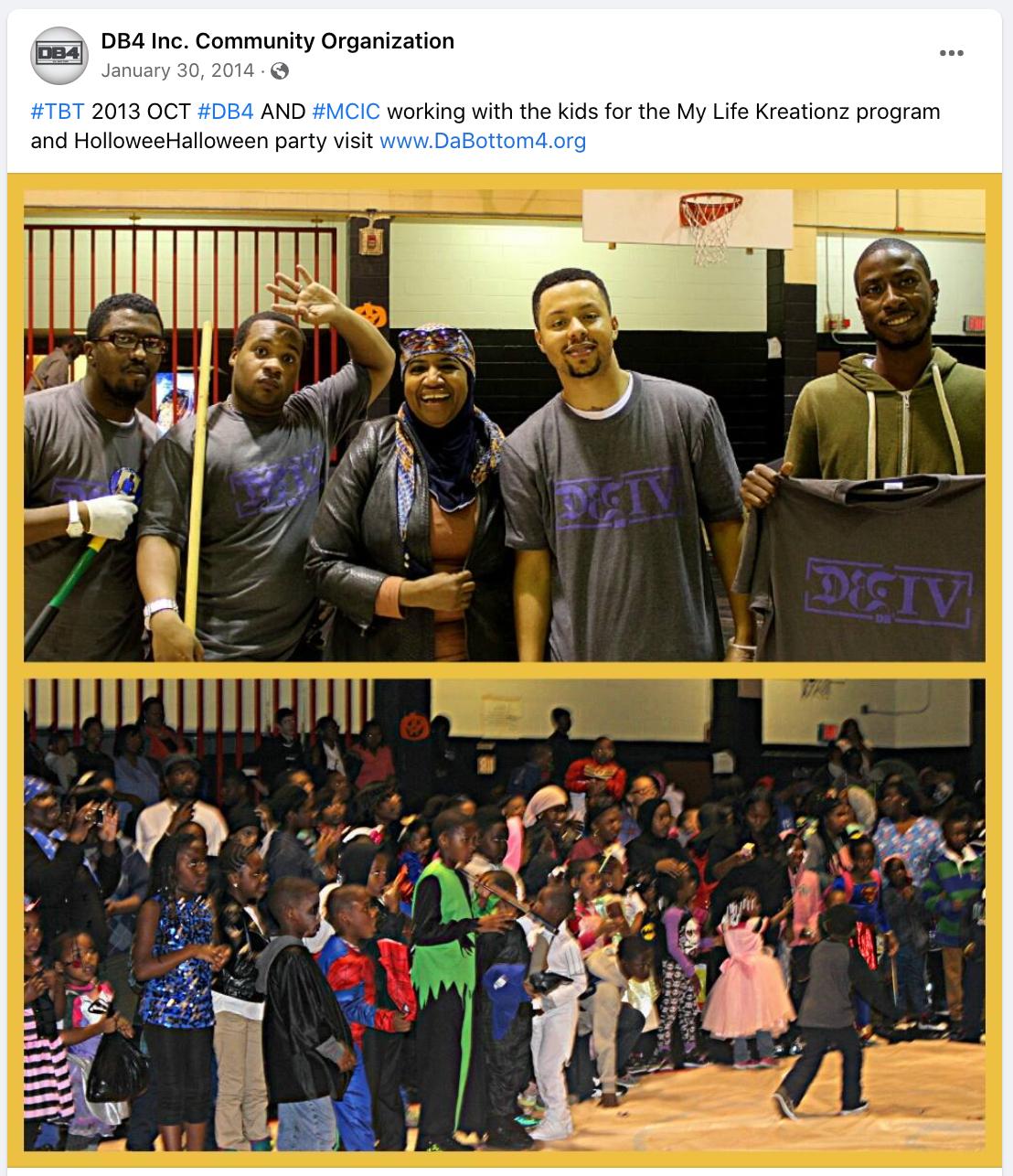
Da Bottom For Community DB4 is a youth advocacy group established in 2012 with support from the CHOICE planning process in Philadelphia’s Mantua neighborhood. The group, which takes its name from Mantua’s neighborhood moniker “DA Bottom” aims to bring influence to community engagement, provide access to educational opportunities and raise awareness of social and economic issues that impact urban communities.
❱ Expand access to youth development programs that build skills and connect youth to their local history and environment such as Urban Boat Works at the
Maritime Museum. and CFET’s summer youth farming internships.
❱ Connect neighborhood youth to City recreation and employment and job readiness programs such Power
Corps and CSSJ jobs
6.3 Maximize the use of existing community spaces
Waterfront South residents expressed a desire for greater access to shared spaces within the community. Residents identified need for spaces for community events, private rentals, and room for new community programming. Several local organizations are home to spaces with the potential to accommodate broader community use, however, residents are often unclear on what locations are available for their use and how they may access them. Developing an inventory of available spaces within Waterfront South and assessing their potential uses will identify opportunities to maximize community access. Developing a central point of information and calendar where community members can identify community spaces and reserve them will broaden access and enable greater programming within the community.
6.4 Activate parks and open spaces
Parks and open spaces in Waterfront South are highly valued by the community, providing opportunities for recreation, gardening and gathering. While each open space plays a unique and important role in community life, they all face challenges related to maintenance, programming and the social challenges associated with homelessness and irregular activities that impact the neighborhood.
Liney Ditch is the main forum of outdoor civic life in Waterfront South. It is heavily used as an amenity by the adjacent Sacred Heart school, neighborhood families and gardening groups. Phoenix Park, managed by CCMUA, is more remote from the residential core and has less active uses but provides a critical link to the waterfront and river access. Residents identified a need for enhanced programming and physical improvements to maximize the benefit of these important public spaces. Memorial Park, a smaller public space at the southern end of the residential core, is home to a well revered WWII service memorial but it is severely disinvested and requires a more in depth vision for long term sustainability. Two sets of strategies including programs and park improvements will help re-energize Liney Ditch and Phoenix Park. Memorial Park will benefit from a long-term vision plan and short-term steps leading to that vision.
a. Programs and events ❱ Sports and recreation activities: partnerships with local organizations can bring existing and well established recreation programs to the neighborhood.
❱ Seasonal park activities: Seasonal events provide residents with opportunities to enjoy time outdoors and in community. Summer movie nights, holiday festivals, community picnics were some of the suggested activities to be added to the schedule of either Liney Ditch or Phoenix Park.
❱ Health and wellness activities: Group walks, dance,
Zumba, or other fitness classes exemplify activities that can be coordinated by local residents.
❱ Arts and culture: local arts and culture organizations are unique partners for creative programming of park spaces. Public art installations, arts & crafts festivals, outdoor theater performances and group reading sessions are examples of activities that will activate the parks and foster connections between arts groups and the neighborhood.
b. Park Improvements The 2020 Greening Waterfront South Plan outlines a program of physical improvements for Liney Ditch and Phoenix Park with amenities identified by the community geared at enhancing park safety, sustainability and useability. During the planning process, neighbors identified the need for additional lighting, interpretive signage and a maritime themed playground at Phoenix Park. Other improvements may include:
❱ Improved sports courts with permeable surface ❱ Shade structures including pavilions and pergolas ❱ Picnic tables and other seating arrangements ❱ Outdoor exercising equipment ❱ Bike racks
❱ Trash receptacles and recycle bins
c. Memorial Park Previous efforts to form partnerships for the maintenance and improvement of the space have stalled and the park is currently plagued by litter, illicit drug use and neglect. While residents occasionally utilize the space for cookouts, the physical condition of the park limits community use and fails to honor those memorialized on the monument. Restoration of Memorial Park to a viable public space in the heart of the residential area requires a plan for physical improvements and long term maintenance. In the short-term, the City should re-establish basic services to clean and maintain the park. The public alley running from Viola to Jefferson street should be included in that effort. On the longterm, the community should seek partnerships with organizations like Trust for Public Land or Project for Public Spaces to fund community-driven plans for the park. The long-term sustainability of the park is an important component of a plan. Consistent maintenance and programming will ensure the longterm success of that open space. Partnerships with City institutions and private sector businesses may provide a path for successful implementation. 6.5 Establish a Family Success Center

Family Success Centers consolidate programs and provide family-friendly activities geared at strengthening families and crisis aversion. Establishing a Family Success Center In Waterfront South will provide much needed resources to local families including housing services, life skills training, parent education and parent-child activities.
6.6 Promote coordination between regional service providers
Waterfront South is home to a number of regional service providers that serve at-risk and in-crisis individuals from a broad geographical area. Community residents understand the value of these organizations and the important role they play in the region but have expressed concern about the impact of their concentration in the community, attracting significant numbers of clients to the area for daily services. By working together and including the community in the conversation, these organizations can identify opportunities to minimize their unintended impact on the neighborhood’s streets and public spaces. Regional service providers should be invited to participate in community dialogue and identify collaborative efforts to ensure a better experience for their clients and the community.
“Supportive Services are important to a healthy and strong community. I am an advocate for our community to focus on building life skills that are essential to Waterfront South: home support, public housing, companion service, waiver respite care services, senior adult services, student support services (college), nutritional services, health and wellness, supported employment training, family counseling, and social group monthly events. A healthy community is a strong community”
Sharine Eliza, Waterfront South Resident
7
Waterfront Access and Enhanced Public Realm
“Call Camden to life. It is a cry to this generous nation, to people of good will everywhere, to do what needs to be done and what surely can be done, to make this city worthy of the thousands of children trying to grow up in it. It can become a beautiful city on the mile-wide Delaware River flowing between it and Philadelphia. From the first day I was here I always dreamed that…the people of Camden would see the water and see the river and know the beauty of the place they reside.” Monsignor Michael J. Doyle , Waterfront South Resident
Multinational corporations and regional authorities occupy much of the land on Camden’s Waterfront South and can contribute to transforming the public realm of that economic zone. The state and its operator, the South Jersey Port Corporation’s, continued industrial development is detrimental to a good quality of life is at odds with New Jersey’s pledge to help environmentally burdened neighborhoods and Waterfront South’s designation as an Environmental Justice community. Priority 7 focuses on specific initiatives to be implemented on the industrial waterfront to improve the physical environment and safety in the neighborhood.

Today, the physical appearance of the area does not reflect the significant business activity and extensive public funding that fuel the district’s economy. Organizational pledges of values such as Sustainability, Equity and Community featured on corporate websites defy the atmosphere of disinvestment and disarray created by poor site management practices and a recurring pattern of disinvestment in the neighborhood’s public realm. While some industrial concerns have shown evidence of greater attention to their physical environment than others, the overall physical appearance of the district is poor and telegraphs a deep disconnect between industrial businesses and the neighborhood where they are located. Fencing, sidewalks and cartways are in poor conditions, trash and debris are strewn about the area and unused trucks and equipment deteriorate on unkept lots. Businesses on the industrial waterfront would benefit from coordinated efforts and collective solutions to improve the physical appearance of the district and better reflect their corporate missions and important roles in the regional and global economy. Established buffers and improved site maintenance along with enhanced lighting, branding and navigational signage will reflect the area’s economic significance and show a commitment to being better neighbors to the residents of Waterfront South and the City of Camden.
7.1 Reclaim the waterfront as a public amenity
While much of the waterfront in the neighborhood is occupied by industrial uses and is mostly inaccessible to the community, significant investments were made over the years by CCMUA and other governmental agencies to improve access to the area, resulting in public spaces like the Michael J. Doyle Fishing Pier and Phoenix Park. Looking into the future, further efforts should be made to build on these investments and expand waterfront access through a network of greenways and safe connections to the neighborhood with easements through EMR and the old MAFCO property. The map below describes the community’s vision for a waterfront greenway running from the old MAFCO property to the north end of EMR’s property, in the area historically known as Kaighn’s Point, where the old ferry terminal connecting Camden to Philadelphia operated. Coordinated investments between EMR, CCMUA and Mynt properties can bring about a transformational improvement to the neighborhood and City. An important first step in that direction includes enhanced connections between the neighborhood and waterfront, establishing a safe and attractive Waterfront Loop between Liney Ditch Park, the Pier and Phoenix Park. Signage, sidewalk improvements, landscaping and lighting are key components of that effort.
Atlantic Ave
Kaighn’s Point
Reading Railraod Terminal at Kaighns Point
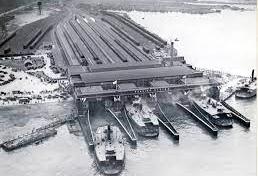
Proposed linear park along the waterfront on industrial properties which gives residents a greater connection to the water. This would run from the MAFCO property up to Kaighns Point. It would also connect Liney Ditch Park directly to the fishing pier.
Proposed Waterfront Loop
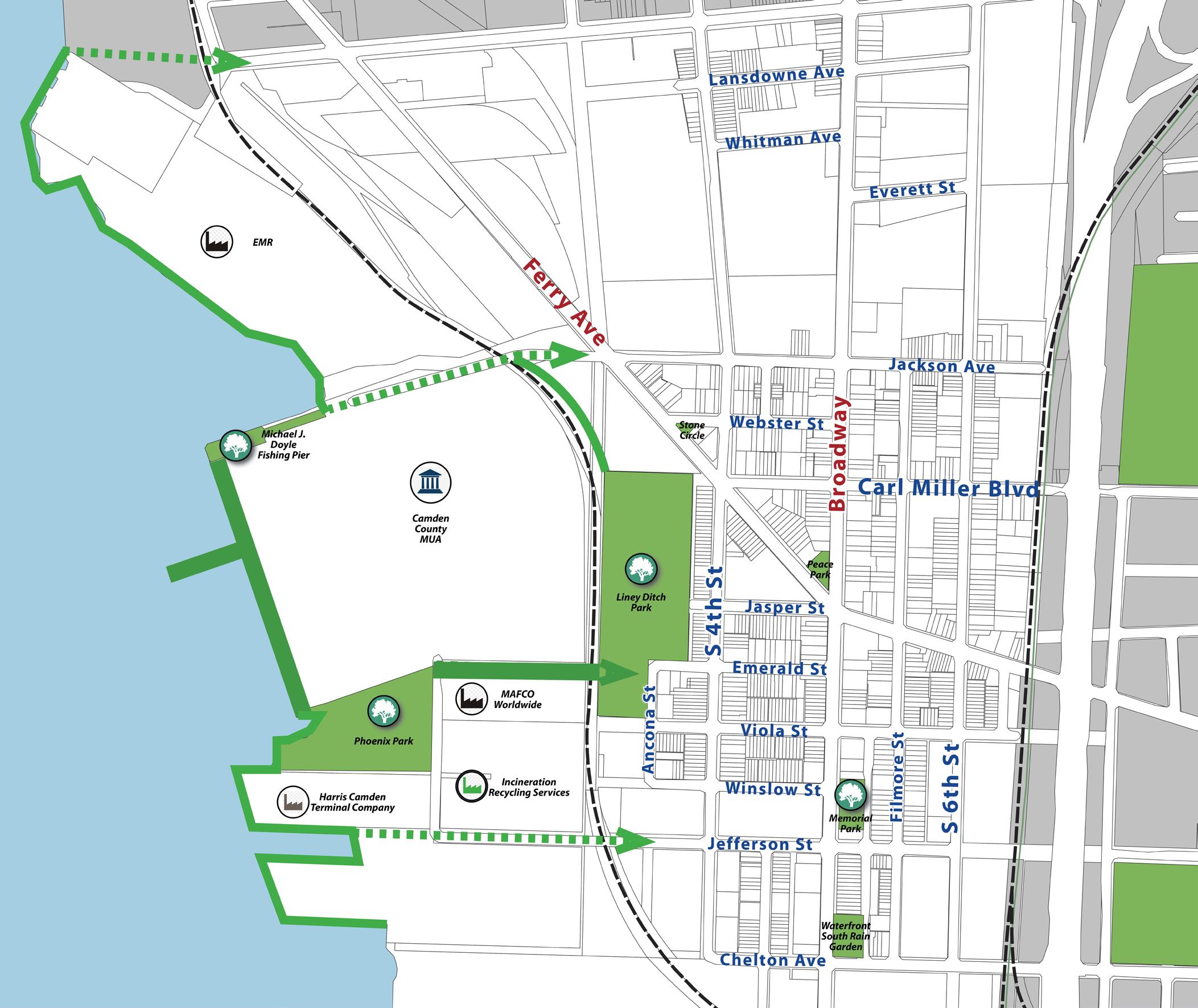
Former MAFCO Property
Existing connection
Proposed waterfront path Neighborhood connections

Birdseye of former MAFCO site
A Game Changer Opportunity!
As companies close or relocate away from the neighborhood, new opportunities arise to introduce new uses and integrate community improvements into future waterfront development. The recent purchase of the old MAFCO property by Mynt Properties represents one such opportunity favoring a positive dialogue between the new owner and the community about site improvements and potential initiatives favoring public access to the waterfront and other amenities.
Monsignor Michael J. Doyle 7.2 Secure and beautify perimeter of industrial properties
Each of the businesses located in the Waterfront South have the responsibility to maintain their properties and ensuring an enhanced neighborhood environment. Key individual site improvements include the following:
❱ Install green buffers around industrial uses that abut residential areas. CCMUA’s buffer at Liney Ditch Park is an example that should be followed by other port industrial businesses.
❱ Increase safety and security at night with improved street lighting and additional site and building lighting.
❱ Secure perimeter boundaries with walls, fencing and landscaped areas.
❱ Develop consistent signage identifying businesses and providing directions for traffic flow. Signage should reinforce truck free zone and assist in directing commercial traffic away from residential areas.
❱ Keep sidewalks clean and litter free
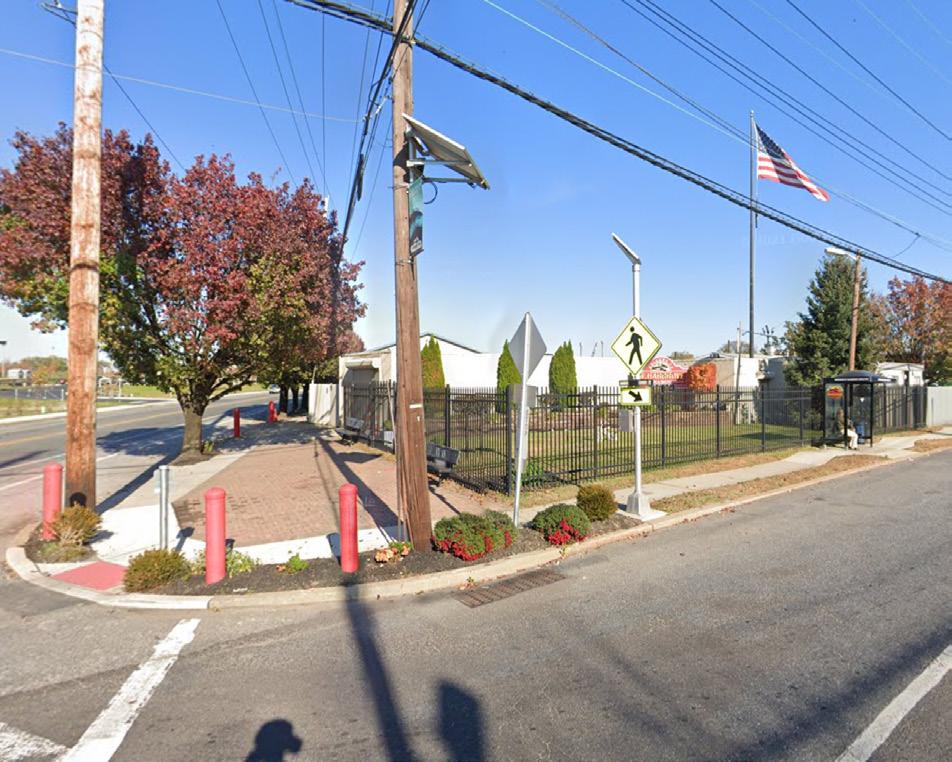
Hargrove Property in Cramer HIll provides a good example of a well maintained industrial property with enhacements to the public realm
7.3 Address eyesore industrial areas
Conrail’s right-of-way cuts a swath through Waterfront South creating a long stretch of unmanaged land from the main rail line along I-676 to the port. The area around the railroad is poorly maintained and poorly secured and includes perilous pedestrian and vehicular crossings. A coordinated effort between the City, Conrail, South Jersey Port Corporation (SJPC) and other businesses that rely on the railroad should include a plan to maintain and improve fringe areas and address abandoned right-of-ways.

Improved railroad right-of-way is a central strategy for a safer and enhanced public realm
Rails with Trails in Oregon shows the potentiol to optimize the use of the railroad right-of-way creating a community greenway 7.4 Improve signage and wayfinding for industrial district
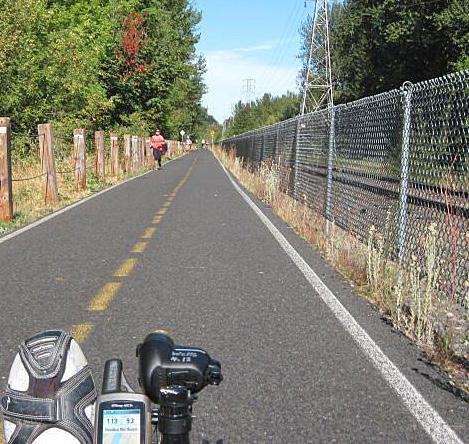
Navigating Camden’s economic zone in Waterfront South is challenging and hazardous. Insufficient signage creates confusion for truck drivers and vehicles arriving from I-676 and conflicts with other patterns of circulation generated in the neighborhood, including private vehicles circulation and parking, transit, foot and bike traffic. Wayfinding signage will go a long way in helping improve circulation and establish the area’s identity as a neighborhood and a distinct district within the city, reflecting the importance of the area as an economic engine in Camden and in the region. Navigational signage will help steer commercial traffic away from the residential core and is an important component of an overall strategy to improve the public realm in south Camden.
7.5 Identify opportunities for green infrastructure in industrial properties
Industrial sites with extensive land areas and higher than necessary percentages of impervious surfaces can help mitigate environmental risks through targeted green infrastructure practices. Partnerships between private businesses, City and County agencies can help identify opportunities for private investments with long term benefits to the community. Examples of green infrastructure initiatives include:
❱ Tree planting along public streets
❱ Green buffers and stormwater
❱ Rain gardens
High Impact
As two of the largest uses in the neighborhood’s industrial waterfront. SJPC and EMR’s efforts to upgrade and enhance their facilities will have a significant impact in the community.
8
Environmental Standards and Social Equity
The primary businesses in Waterfront South’s industrial district are multinational corporations and regional authorities with reach and resources that extend well beyond the neighborhood’s boundaries. EMR, Covanta and Holtec are multinational corporations with global footprints in several countries. CCMUA and South Jersey Port Authority are regional authorities.
These organizations publicly share commitments to social equity and environmental responsibility, but few have successfully aligned their impact at the local level, in this majority minority community, with their corporate goals. Residents have expressed concern about the multinational corporations, calling for compliance with environmental standards. Specifically, residents identified the Covanta and EMR corporations as industries of concern due to their potential environmental and health impacts. A key priority for the next ten years includes a broader and concrete commitment from industrial businesses to the community, working to minimize their environmental footprint and maximize their social impact. Stronger environmental standards for their operations in Waterfront South and commitment to the adopted corporate values of equity will foster the development of a green and socially responsible economic zone that is a both a better neighbor to the Waterfront South’s community and a stronger representative of the resurgent economy of the city of Camden. To that end, EMR has publicly pledged to encapsulate their grinder equipment and to beautify their facility located in Waterfront South. The Covanta corporation has committed to a new baghouse installation at the Camden plant, making emissions data publically available, minimizing emissions and reducing discharges, and continued open communication with the local community. In that same vein, future businesses looking to locate within the neighborhood’s industrial zone should be evaluated according to their commitment to both environmental responsibility, environmental justice, and social equity. These parameters will foster the development of a green economic district that redefines its relationship to the community from one of resource extraction and overburdening to an example of equitable creation of wealth and opportunity, with a net positive social and environmental impact.

Best Practices
The CCMUA’s Green Energy Initiatives exemplify organizational goals aimed at reducing their environmental footprint and supporting improved quality of life for residents. Key initiatives include:
❱ Energy self-sufficiency ❱ Environmental performance review ❱ Green infrastructure projects ❱ Living shoreline ❱ Water conservation ❱ Committment to “Zero odor” goal
8.1 Report environmental impact
Baseline data on pollutant emissions is critical to understanding environmental risks in Waterfront South and the region. Although some businesses already make their data easily available to the public, this is not yet common practice across the neighborhood’s economic zone. Commitment to shared and current data is a first meaningful step towards communication and a helpful tool in the dialogue towards environmental goals.
At the state level, communication with NJDEP to advocate for regular and updated information about the cumulative impact of environmental hazards to the community should be advanced. As discussed under Priority 1, the neighborhood is due for an update to the 2005 Air Quality report.
8.2 Develop and communicate goals for a clean and green economic zone
The 2020 New Jersey Energy Master Plan establishes ambitious goals of 100% clean energy by 2050. The 2018 Sustainable Camden County Plan establishes additional benchmarks at the local level for sustainability. These plans provide a helpful framework for collective responsibility. Private businesses in Waterfront South can do their part in this effort and help achieve local goals through a shared vision and commitment to individual organizational steps charting a path to sustainability, resiliency and reduced environmental impact. On the long-term, businesses should be looking at opportunities to move from a fossil fuel economy to a green economy fueled by clean and renewable energy.
Commit to socially responsible business practices that focus on extending economic benefits to the residents of Camden and Waterfront South. Establish programs to hire locally and source locally and support to minority and women-owned businesses. 8.4 Commit to sustainable waterfront development practices
Much of the industrial land in Waterfront South is also part of the environmentally critical Delaware River waterfront. The City of Camden sustainability standards and WEDG standards developed by the Waterfront Alliance provide a roadmap for sustainable waterfront development and a process for verification and vetting of proposed development. Businesses looking to upgrade and expand their facilities should strive to incorporate those guidelines in their projects.
8.5 Prioritize socially and environmentally conscious businesses
Future businesses locating in the neighborhood’s economic zone, who benefit from public funding in infrastructure as well as tax incentives should be evaluated on the basis of environmental and social performance standards. The Aspire Program, the new economic development program managed by NJEDA, incorporates these goals as parameters for project selection with a focus on development projects that advance climate resilience, environmental justice, equitable development and workforce housing opportunity.
8.6 Plan for the long-term reclamation of the waterfront land
Industrial uses in Waterfront South have evolved over the last century in response to economic trends and technological advancements. These shifts have had a significant impact on land uses. While current industrial uses play an important role in the regional economy and may remain in the area for years to come, demand for land in the area will continue to change and opportunities to re-imagine the use of land may arise. Residents expressed a desire to see the waterfront restored and reimagined.
9
Atlantic Avenue as a City Gateway
Atlantic Avenue plays an important role as an entry point to Camden from I-676, serving as a gateway to the City and a primary access to both the industrial waterfront and South Camden neighborhoods. Running from Front Street to Haddon Ave, the avenue serves as an important connector but has the potential to become more than a throughway with an effective land use strategy that builds on convenient access from the region to establish a new node of services and commercial activity in the City. The area can cater not only to the demand for services and amenities generated by local residents and industrial businesses, but to a broader regional market that includes visitors and commuters who access the City from I-676.

A number of concerns were expressed by the community with respect to Atlantic Avenue and surrounding blocks. Traffic and public safety rank high among those concerns, with an emphasis on the conflicts between truck traffic and neighborhood circulation. Drug activity, homelessness and prostitution have also found a home in the area, reinforced by the cluster of regional social services located on the avenue and a desolate environment marked by abandoned properties and vacant land.
Traffic and circulation improvements proposed by Camden County and anticipated for implementation in the next few years can be the catalysts for change around Atlantic Avenue and help leverage public and private investments towards the area’s revitalization. A strategic plan, focusing on land use, infrastructure upgrades and an assessment of market potential will help identify redevelopment opportunities for the corridor and surrounding blocks. A re-imagined Atlantic Avenue can spur economic development and have a transformative impact for Waterfront South and other neighborhoods in south Camden.
9.1 Improve safety and connectivity between neighborhoods
As the County embarks on physical and traffic improvements for Atlantic Avenue, consideration should be given to additional measures, aimed to strengthen connections between Waterfront South and surrounding neighborhoods, primarily Central Waterfront and Bergen Square. Additional improvements to the area should include:
a. Clear and secure vacant land along the corridor. Much of the land along Atlantic Avenue functions as a cemetery for abandoned trucks, shipping containers and other vehicles. A first step in the transformation of the avenue involves full removal of abandoned vehicles along with efforts to clear and secure vacant lots. b. Pavement and re-surfacing. Streets around Atlantic Avenue that are in severely deteriorated conditions should be included in the County’s plans for road improvements. c. Improved sidewalks, crosswalks, signage, lighting and ADA compliance. Streets around Atlantic Avenue that are in severely deteriorated conditions should also be included in the scope of improvements, ensuring safer pedestrian connections between neighborhoods.
9.2 Create a long-term plan for the Atlantic Avenue gateway zone
While roadway and infrastructure improvements will address immediate needs for the avenue and the industrial zone, a strategic plan will help establish a long-term vision for the future of the area, identify potential market opportunities and redevelopment priorities. The future implementation of a light rail stop in Waterfront South will generate a renewed demand for land in the area, expanding services, amenities and job opportunities. A vision for the Atlantic Avenue Gateway Zone will require a coalition of neighborhood organizations, businesses and City agencies in support of planning and implementation efforts.
9.3 Leverage access and economic activity to promote new services and amenities
Atlantic Avenue can serve as a commercial corridor for South Camden, serving multiple needs at the local, city and regional level:
a. Community-oriented services: Such as medical offices, healthcare facilities and pharmacies will serve neighborhoods to the north and south of Atlantic Avenue. b. Free standing commercial spaces: Such as food stores, chain stores and restaurants, banks and garden centers can be accommodated with space for parking and service areas. c. Light industrial uses: Such as construction offices, carpentry shops and light manufacturing can benefit from easy access to I-676 and the region.
9.4 Identify opportunities for anchor development on Atlantic & Broadway
The concentration of vacant properties around the intersection of Atlantic & Broadway provides an opportunity for a meaningful gateway development. Much of the first block of Broadway between Atlantic and Mechanic Street is vacant and lends itself for an anchor mixed-use development opportunity. Coordinated efforts between the City Planning Department, CRA and neighborhood organizations can help identify potential uses for the site.

The Invest South/West website shows the extensive community engagement process and one of the winning RFP responses.
A Game Changer Opportunity!
Invest South/West in Chicago provides a useful model for an equity driven process that could inform development of a long-term plan reimagining Atlantic Avenue as a vibrant city gateway. A coalition of city agencies, local service providers, business interests and community groups including Heart of Camden, Cooper-Grant Neighbors Association, the South Jersey Port Corporation and Camden Community Partnership can come together to develop a wholistic strategy for public improvements addressing the needs of local businesses and community residents. The concentration of vacant land at Atlantic and Broadway provides an ideal opportunity for a catalytic anchor development that can transform Atlantic Avenue.
The Invest South/West initiative layers economic development resources and planning tools to spur the development of new public amenities, retail, and community services for 10 historically disinvested commercial corridors in the city of Chicago. The initiative marshalled resources of multiple city departments, community organizations and corporate and philanthropic partners toward the reimagining and reinvesting in the targeted corridors. The process provided support for local businesses, funded public realm improvements, and spurred the restoration of historic buildings. Input from community engagement events and roundtable groups of stakeholders informed the alignment of public investments and guided an RFP process for catalytic private investment. Winning RFP responses responded to the community planning process with mixed-use development proposals that included business incubator space, community centers, commercial and industrial development.
10
Build Capacity
The successful implementation of this Neighborhood Plan and any other community initiative hinges on the ability displayed by residents and local organizations to organize, advocate, coordinate and execute projects. The path to project implementation is long and requires consistency, representation and coordination. A careful assessment of the current capacity and commitment from local groups and individual organizations will help inform the steps and resources required to strenghten community capacity.

10.1 Build Capacity for Civic Engagement
Waterfront South has a long tradition of community organizing, advocacy and action. Over the years, residents have come together regularly to fight for environmental justice and to advance goals for community building and neighborhood improvements. The implementation of this neighborhood plan provides the community a renewed opportunity to organize and revisit goals towards civic engagement and community action. A multilayered approach to capacity building will help solidify the community’s organizational ability to advocate for and advance neighborhood priorities while creating new opportunities for resident involvement and leadership. It should also help establish clear channels of communication between residents, City agencies and other stakeholders in the community. The following strategies will help reinforce engagement and reconnect neighbors around shared goals:
a. Strengthen the resident groups A key immediate goal includes the need to broaden resident participation at local resident groups, expanding lines of communication with residents who do not traditionally engage in community affairs. That effort should focus on outreach to immigrants and resident representation across age, race and income groups.
❱ Identify an existing organization and/or resident group to act as the organizing body and community voice. Secure funding to engage a community organizer and collaborate with regional and national organizations for training opportunities preparing residents for organization, advocacy and social change activities.
❱ Improve outreach and communication, developing a communication plan with platforms that maximize reach across multiple resident groups. A community website, Facebook page, community texting and printed newsletters are some of the standard options available at minimal costs. Consider the need to communicate in multiple languages as needed.
❱ Maintain a regular schedule of community meetings throughout the year and identify potential opportunities for an annual community gathering or hands-on community project (annual neighborhood clean-ups, annual community picnic, and others).
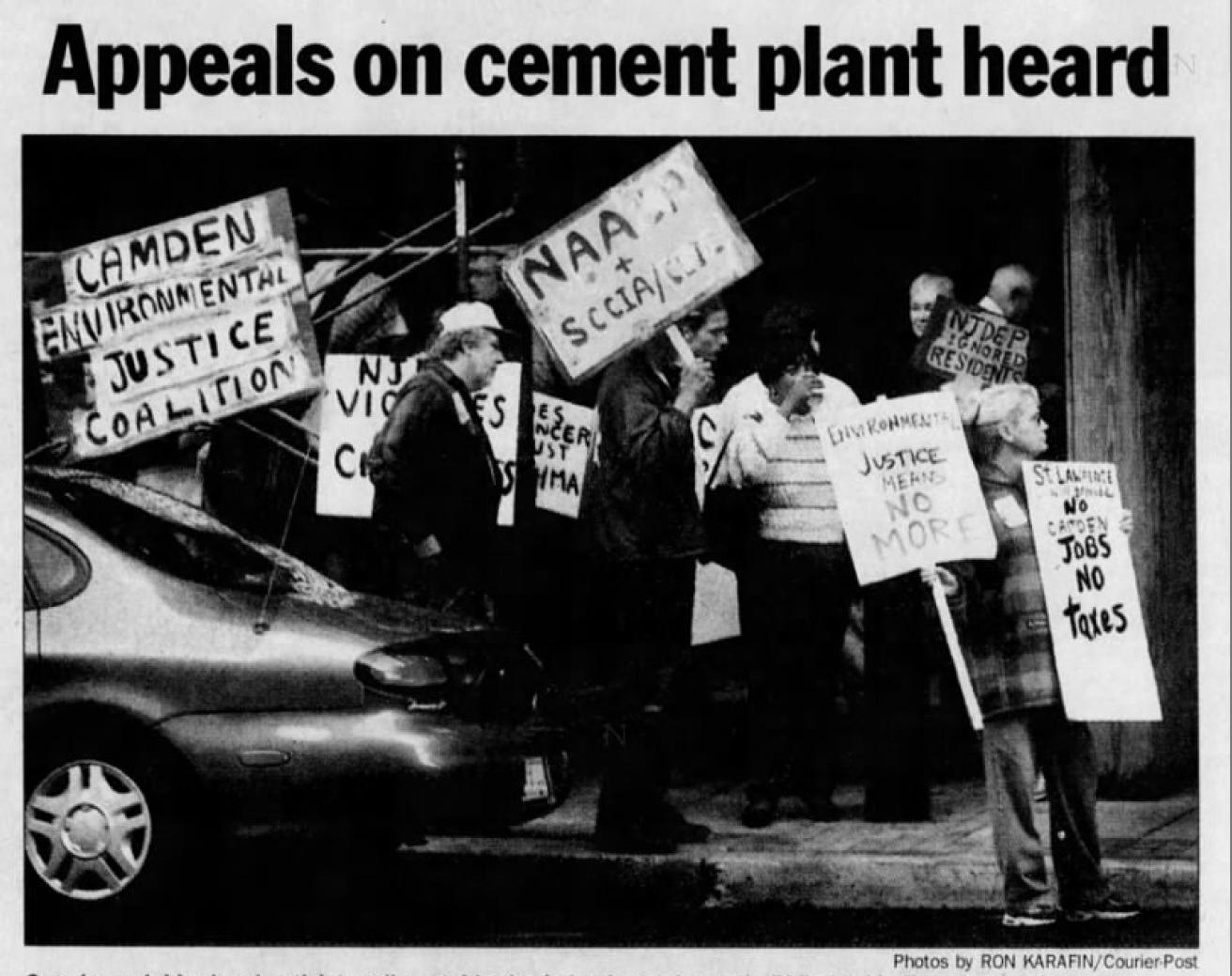
Source: Courier-Post
South Camden Citizens in Action
South Camden Citizens in Action’s history of grass roots neighborhood activism and fighting for environmental justice provides a hyper-local example of an organized community achieving results. Formed in 1998 to “Stop the Stink” SCCA battled environmental racism impacting Waterfront South in the press, street and courtroom. Spurred by opposition to a concrete slag grinding factory South Camden Citizens in Action vs NJDEP, filed in 2001, charged that the DEP employed discriminatory permitting practices in locating a concentration of high impact uses within Waterfront South. While their initial legal victory was ultimately overturned in Federal court the group’s advocacy won millions of dollars in concessions and improved environmental controls. Importantly, through the activism of SCCA, the environmental hardships of Waterfront South were brought to the attention of the public and put to bear on local politicians. Community action successfully overturned a redevelopment plan that threatened to displace the community, forced the city to reroute diesel trucks and spurred significant investment in improved environmental operations at CCMUA. The grass roots actions of SCCA forms the basis for the dialogue around environmental justice in Waterfront South today amid new threats of expanding industrial use and a need for renewed attention on dangerous practices and equitable development.
❱ Identify regular funding streams in support of community events, communication and outreach.
❱ Establish a resident training program to educate, empower and build capacity around planning, zoning and development issues shaping land use decisions in Camden.
b. Establish a block ambassador program In its work with the Waterfront South community, DCCB identified the development of a block ambassador program as a key public safety initiative. Block leaders, identified in the neighborhood as Community Connectors, can help advance multiple neighborhood initiatives including community communication, public safety projects, tree planting and other physical improvements. A block-level program will help residents take ownership of their immediate areas and work in collaboration with their neighbors to improve living conditions, one block at a time.
c. Establish environmental justice task force Multiple conversations held with residents during the planning process suggest the opportunity for a dedicated community initiative around environmental justice. While Waterfront South residents have been able to quickly mobilize around recent environmental threats and incidents, a consistent effort to advance the community goals for a clean and healthy environment through information, organization and advocacy will increase community awareness and empower residents to take a more active role in the dialogue about the future of their neighborhood.
The Waterfront South Environmental Justice Task Force can convene and lead the establishment of a Camden Environmental Justice and Climate Action Plan, addressing a comprehensive strategy around environmental issues at the city level and its impact on the environment and public health.
d. Establish a Youth civic group Residents have also expressed the desire to find opportunities for actve youth participation in community projects. The DB4 youth team in Mantua, Philadelphia, provides an inspiring example of a local youth group supported by the local civic association to promote projects and events geared to young residents and addressing topics of their interest. In partnership with local service providers and institutions, DB4 held community events around community projects and hosted seminars and round tables about employment opportunities, higher education, health and wellness among others. A similar initiative in Waterfront South could help leverage teenagers and young adults to action advancing community projects included in this neighborhood plan.
Local neighborhood organizations fulfill incredibly important roles as local partners on the ground who are charged with turning the community’s vision into concrete projects. Their ability to carry out short- and long-term revitalization initiatives hinges on a number of factors, including clarity about their mission in the community, an effective board of directors and a skillful executive staff able to address the multiple facets of community development work.
Organizations like the Heart of Camden and the six groups that form the Waterfront South arts and culture community are tasked with addressing a broad range of community needs. While originally organized around a primary mission, they have taken on a number of additional roles over the years, in response to the community’s growing demand for services. Recommendations from this very neighborhood plan assign potential new roles to each of these groups, further justifying the need for a thorough assessment of current and future capacity required to advance neighborhood goals. A close focus on board capacity, technical and financial capacity will help prepare community groups for plan implementation:
a. At the board level A focus on inclusion and diversity will help ensure equal representation, including resident representation and local groups who are typically underrepresented in organizational leadership. Strategic review of their mission and organizational goals will also help existing boards revisit their roles in the process of plan implementation.
b. Administrative, staff and technical capacity Capacity at the organizational level includes a primary focus on the people, skills, and resources required to deliver services. Coordinated efforts should be made to identify opportunities for strategic hiring, training, and technical assistance. Recent efforts by the Waterfront South Arts and Culture community to identify opportunities for coordinated work between organizations and shared resources exemplify effective initiatives for enhanced capacity. 10.3 Establish Partnerships
Positive partnerships and coalition building between community stakeholders are critical to the successful implementation of this neighborhood plan. Consistent collaboration between residents, community groups, governmental agencies and local businesses will allow the stakeholders to act on plan implementation, working towards common goals, shared efforts and bringing resources to bear towards positive outcomes.
a. Waterfront South Collaborative Establishing a collaborative forum for stakeholders to work together is a first critical step towards implementation. The Waterfront South Steering Committee, formed originally by the Heart of Camden to help inform the neighborhood plan, can easily pivot as an implementation collaborative, establishing a regular channel of communication between residents and organizations in the private, public and non-profit sectors, focused on information sharing, project updates, shared initiatives and relationship building. The Waterfront South Collaborative (suggested name for this implementation entity) should include representation from the community and organizations identified on the plan as key implementation partners.
b. Camden Waterfront Coalition
At the City level, residents discussed the goal to establish a Camden Waterfront Coalition, bringing Waterfront South neighbors together with residents of other waterfront communities in the City to address challenges around waterfront access, environmental risks, land use and resilience against the impact of climate change. Shared efforts between communities like Cramer Hill,
North Camden, Central Waterfront and Waterfront
South will help amplify community voice around significant issues faced by Camden residents.


